Baseball in Early Los Angeles
Early Baseball in Los Angeles |
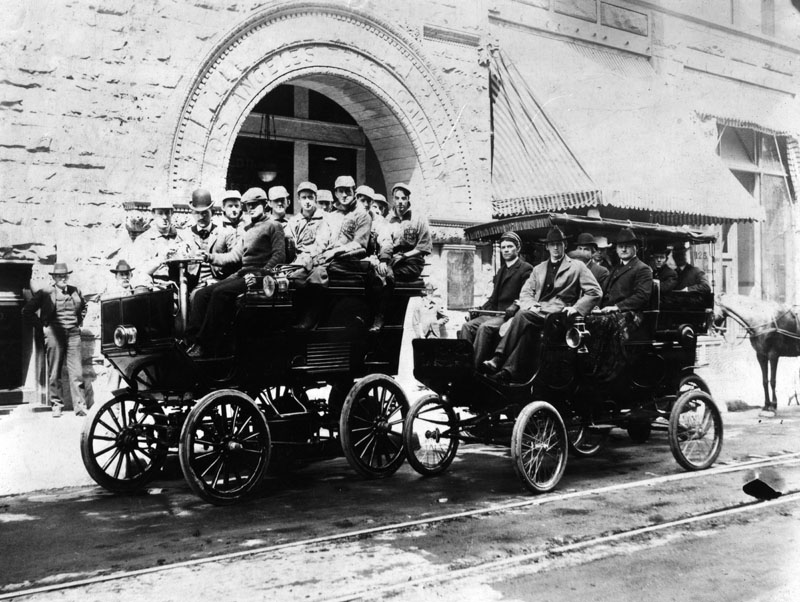 |
|
| (1902)* - Two unidentified vehicles used to transport a large number of people,"Sports" is the note on the photograph. From another copy of the subject the team is identified as the "Bank baseball team, Second Street and Spring Street, 1902." Los Angeles Trust Company, engraved in the arch of the doorway to the building in the background, may be the "Bank" referred to. |
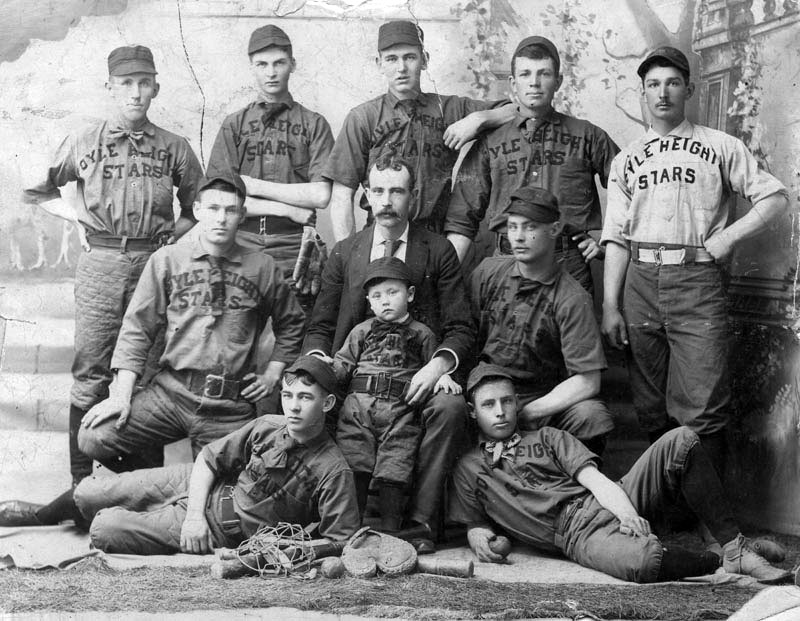 |
|
| (ca. 1905)* - Professional baseball came to Los Angeles in the early 1890s, with the Los Angeles Angels of the short-lived California League. But, at the turn of the 20th Century, neighborhood teams like the Boyle Height Stars flourished throughout Southern California. |
Historical Notes 1892 - The original Los Angeles Angels baseball team, playing with the four-team California League, plays through the 1893 for one season. 1893 - The California League Los Angeles Angels and the team from Stockton play a nighttime exhibition game - the first ever night professional baseball game on the Pacific Coast. The game is played at Athletic Park in Los Angeles. 1903 - Los Angeles joins the formation of the Pacific Coast League with the debut of the Los Angeles Angels baseball team. The team had no relationship to the team that played 1892-1893. The rival Pacific National League also debuts a team in Los Angeles, but it plays for barely a season. |
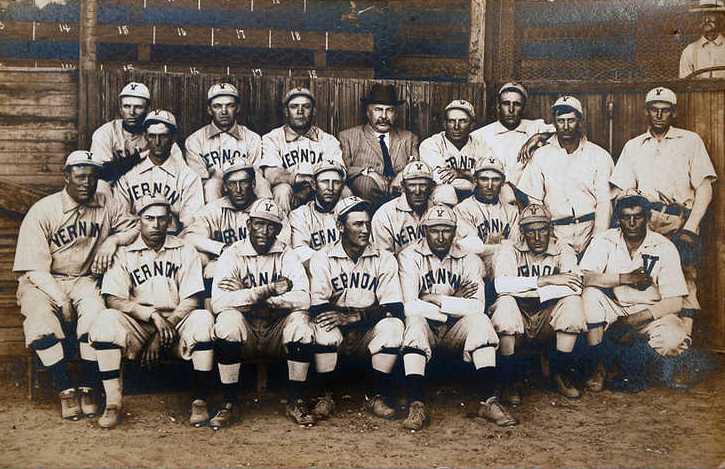 |
|
| (1910)^^ - Team picture of the Vernon Tigers in 1910 with owner Pete Maier seated in the back center. |
Historical Notes In 1909 Peter Maier, a meatpacker, built the first stadium, Maier Park, at 38th and Irving in the city of Vernon. The Vernon Tigers would play there until 1913 when they moved to Venice (Not coincidentally, both Venice and Vernon were the only two cities in the area where the sale of alcoholic beverages was legal). Weak attendance in Venice forced Maier to dismantle the entire stadium and move it back to Vernon in 1915. During their history the Tigers also played at Washington Park when the Angels were on the road. Doyle's Tavern was butted up to left field at Maier Park and it was rumored that there was a door in the left field wall where some players would run in to Doyle's for a quick beer between innings. It was also used for letting the crowd in and out of the park. The team was eventually purchased by Roscoe "Fatty" Arbuckle in 1919 who was a Hollywood movie star. Shortly thereafter the team had a scandal which was a lesser "Black Sox" type event that resulted in several player suspensions. In 1925 the franchise was sold to San Francisco investors who renamed the team the Mission Reds. The Reds moved back to LA in 1938 and morphed into the Hollywood Stars. |
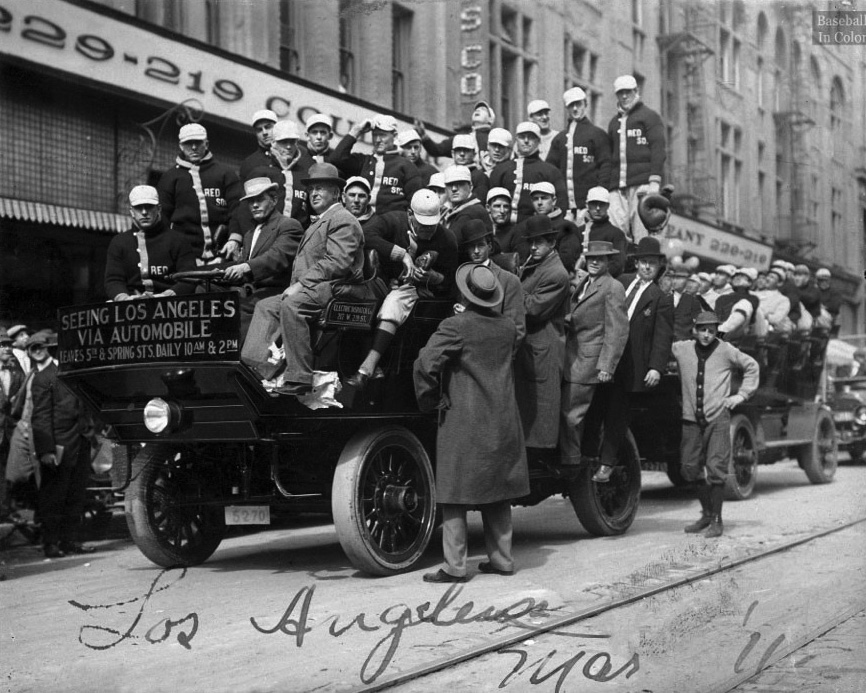 |
|
| (1911)* – View showing the Boston Red Sox in downtown Los Angeles. Sign on the vehicle reads: “Seeing Los Angeles via Automobile” |
Historical Notes The Boston Red Sox were in town on March 9th, 1911 to play the Vernon Tigers at Washington Park – if the weather permitted. Note that several of the players are looking up to the sky at, possibly, rain clouds. A Los Angeles Times article dated Mar 9, 1911 with the title ‘Ball Game If Weather Permits’, read as follows: "The Boston Red Sox and the Vernon team are scheduled to play a game this afternoon at the new Washington Park if— Hap Hogan said last night that “if” meant two things: That the game would be at the Washington Park if “It” did not rain all night and if the ground was not too soft; and if not at the Washington street ground it would be at the Vernon Park, if there was not too much rain. With this beautifully lucid and clear statement everyone should know as much as any one about “weather” there will be a ball game this afternoon. Dillon called off the San Bernardino game last night." |
Chutes Park (aka Washington Park)
 |
|
| (ca. 1911)^^* - Panoramic view of the Chutes Park (also known as Washington Park). It was located on the north end of Chutes Park on Washington Blvd. and Main Street. This was the first home of the Los Angeles Angels. The Chutes Park water slide is visible beyond right field. Click HERE to see more on Chutes Park. |
Historical Notes In 1900, a baseball diamond was completed on the northern end of the Chutes Park, with a team to play in the new California League. It would be the first team to be called the Los Angeles Angels. It was also home of the Vernon Tigers. Following games, a gate in the center field fence was opened and fans were allowed to enter the theme park. |
.jpg) |
|
| (ca. 1911)^ - Panoramic view of Chutes Park baseball field as seen from right field. |
Historical Notes Chutes Park was replaced by Washington Park in 1912, which had been built nearby just two blocks away at Washington and Hill Streets. The Chutes / Washington area was abandoned entirely when the Angels moved to Wrigley Field at 42nd Street and Avalon Boulevard. The Chutes Park baseball field has also been referred to as Washington Park.*^ |
* * * * * |
Washington Park
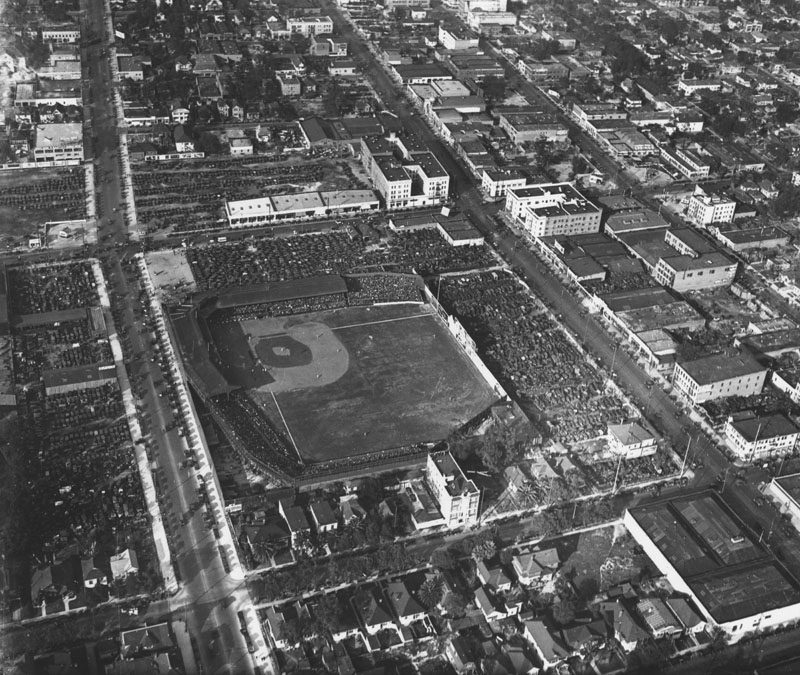 |
|
| (1924)^* - Aerial view of the 'New' Washington Park which was home to the Los Angeles Angels from 1912 until they moved to Wrigley Field in 1925; The Vernon Tigers, who in 1938 would become the Hollywood Stars, also played at Washington Park but only when the Angels were away. |
Historical Notes The Venice PCL entry of 1913-14 also played its home games at Washington Park, except for Sunday morning and special holiday games. In 1915, they would move back to Vernon and once again become the Vernon Tigers. A football game between USC and California was played at Washington Park on November 25, 1915. It drew 8,000 spectators, the largest crowd to have seen a football game in southern California at that time. |
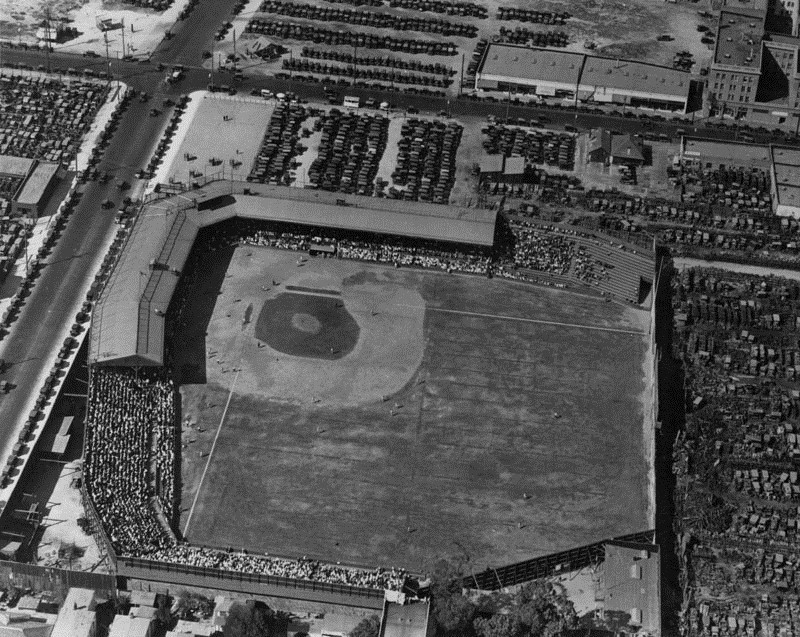 |
|
| (1924)* - Aerial view of Washington Park, home of the Los Angeles Angels. Hill Street is on the left and Washington Boulevard is at top. |
Historical Notes From 1903 through 1957, the Los Angeles Angels were one of the mainstays of the Pacific Coast League, winning the PCL pennant 12 times. The Angels, along with the Portland Beavers, Oakland Oaks, Sacramento Solons, San Francisco Seals, and Seattle Indians were charter members of the Pacific Coast League which was founded in 1903. |
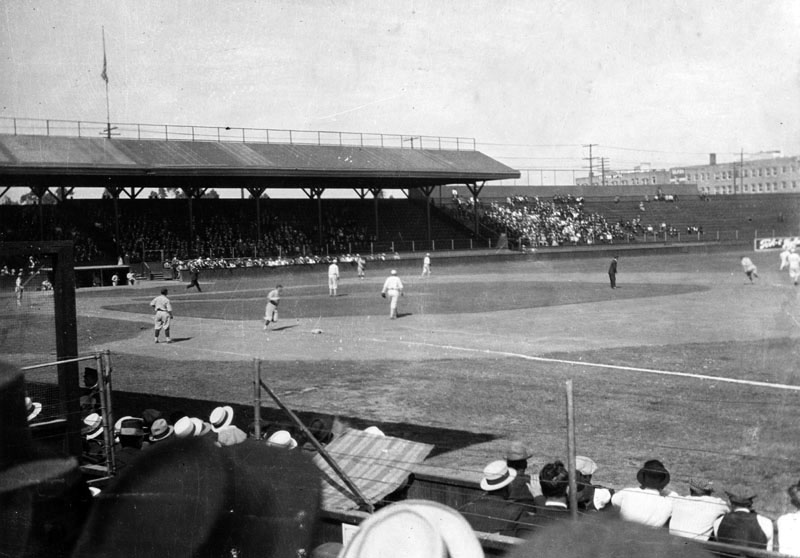 |
|
| (1917)* - View of a game at Washington Park. It is unknown which team is the batting team, and which is the fielding team, but it may be either the Los Angeles Angels or the other home team, the Hollywood Stars. |
Historical Notes In 1921, the team was purchased by chewing-gum magnate William Wrigley Jr., the owner of the Chicago Cubs of the National League. When Wrigley could not get the city of Los Angeles to make the improvements to Washington Park he requested, he began construction of his own 21,000-seat stadium, appropriately named Wrigley Field, at 42nd Place and Avalon Boulevard in what is now known as South Central Los Angeles. The Angels began play at Wrigley in 1926, and responded by winning their eighth PCL pennant, finishing 10½ games ahead of the second-place Oakland Oaks.*^ Washington Park was eventually demolished in the Mid-1950s. |
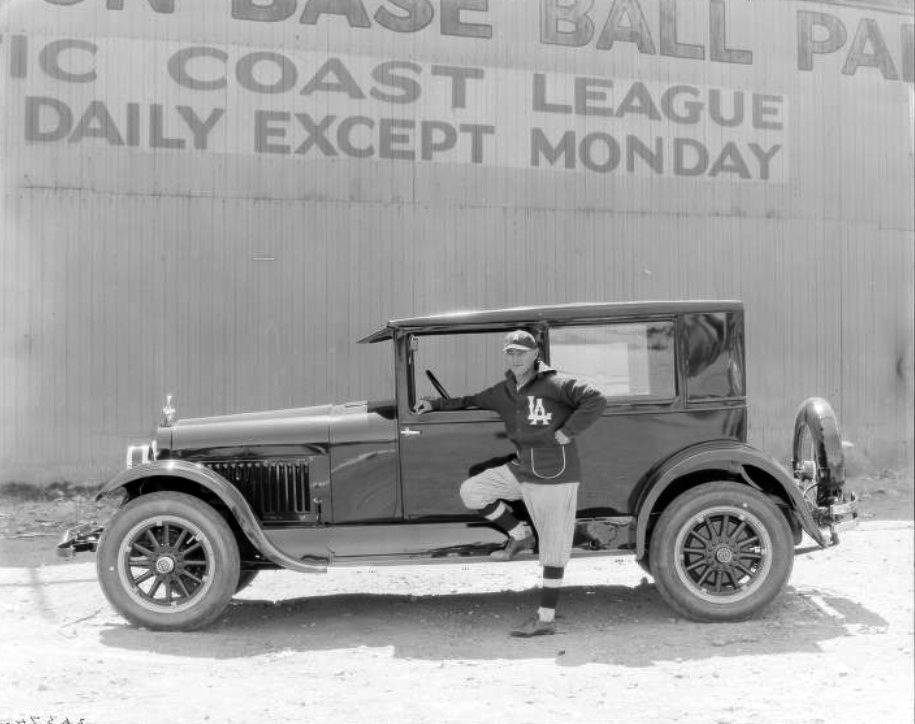 |
|
| (1925)* – View showing Charlie Root posing in front of a Hudson Coach at Washington Park. |
Historical Notes Charlie, a Chicago Cubs pitcher made famous by the apocryphal story of Babe Ruth calling his shot by pointing to the center field bleachers with Root on the mound, is seen here in his last year in the minor leagues with the Los Angeles Angels (the triple-A Cubs affiliate). The car may have been his but the photograph was commissioned by Walter M. Murphy Motors Company for an advertising shot. This is the last year the Angels will play at Washington Park moving into their own Wrigley Field, at 42nd Pl and Avalon, next season. |
* * * * * |
White Sox Ball Park (Los Angeles)
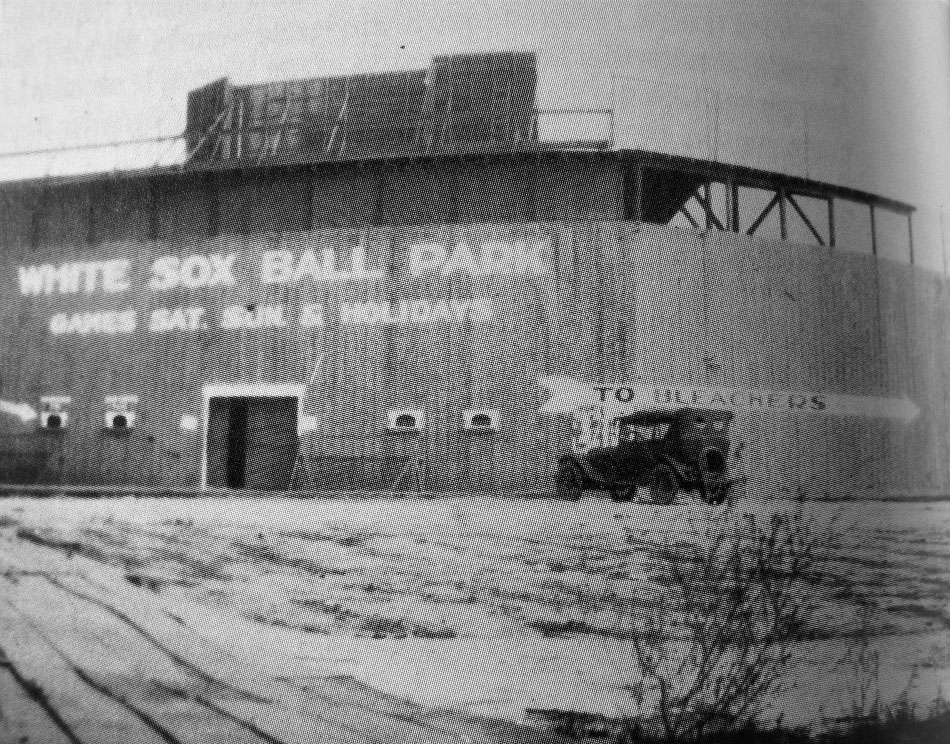 |
|
| (ca. 1924)* – View showing White Sox Ball Park, located on the corner of 38th Street and Compton Avenue in South Los Angeles. The 7,000 seat park was the home of the California Winter League. Sign reads: "Games Saturday, Sunday, & Holidays" |
Historical Notes Italian American brothers, John and Joe Pirrone, used their earnings from their wholesale fruit business to purchase the land to build White Sox Park in 1924. Joe Pirrone organized the California Winter League to lure Negro League teams to southern California to play against local semi-pro teams and minor league teams, including Japanese American and Mexican American teams. During the 1920s African Americans were barred from playing in Pacific Coast League parks including Wrigley Field and Gilmore Field in Los Angeles. According to William McNeil, “The California Winter League was apparently intended as a showcase for Negro league baseball. White Sox Park, which was strategically located in or near black sections of the city, hosted the majority of league games.” Some of these teams included the Kansas City Royals and Monarchs, Philadelphia Giants, Detroit Giants and Nashville Royal Giants. There were also all-black teams from the sandlots of Los Angeles, such as the Royal Giants, Colored Giants, Monarchs, Stars and many others.* |
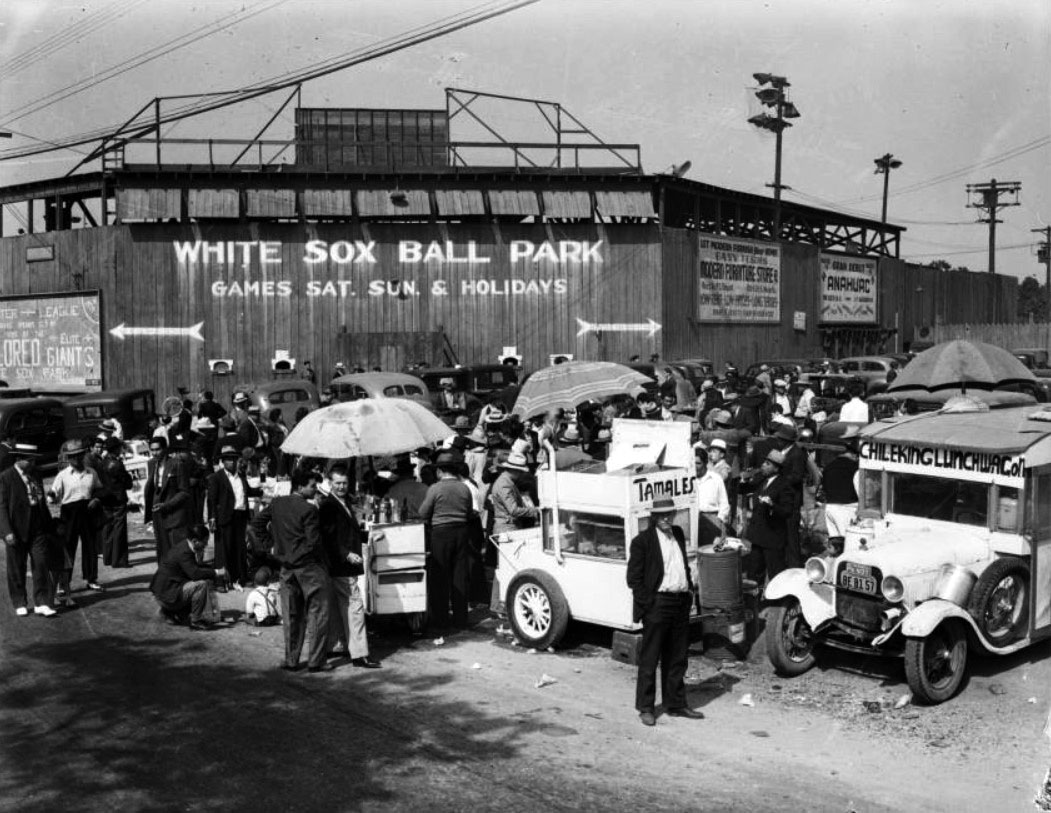 |
|
| (ca. 1939)^ – View showing customers and vendors outside the White Sox Baseball Park in South Los Angeles. Sign on the stadium says "Winter League grand opening Oct. 9th.1939. Home of the Colored Elite Giants, White Sox Park." |
Historical Notes IWhite Sox Park was also the home of Mexican American baseball teams. Mexican American baseball teams and leagues dotted the southern California landscape “working to play, playing to work.” El Paso Shoe Store from San Gabriel fielded one of the strongest teams called, “Los Zapateros,” that played a majority of its games in White Sox Park. Hollywood celebrities, city political figures and the Mexican Consul attended games at White Sox Park.* |
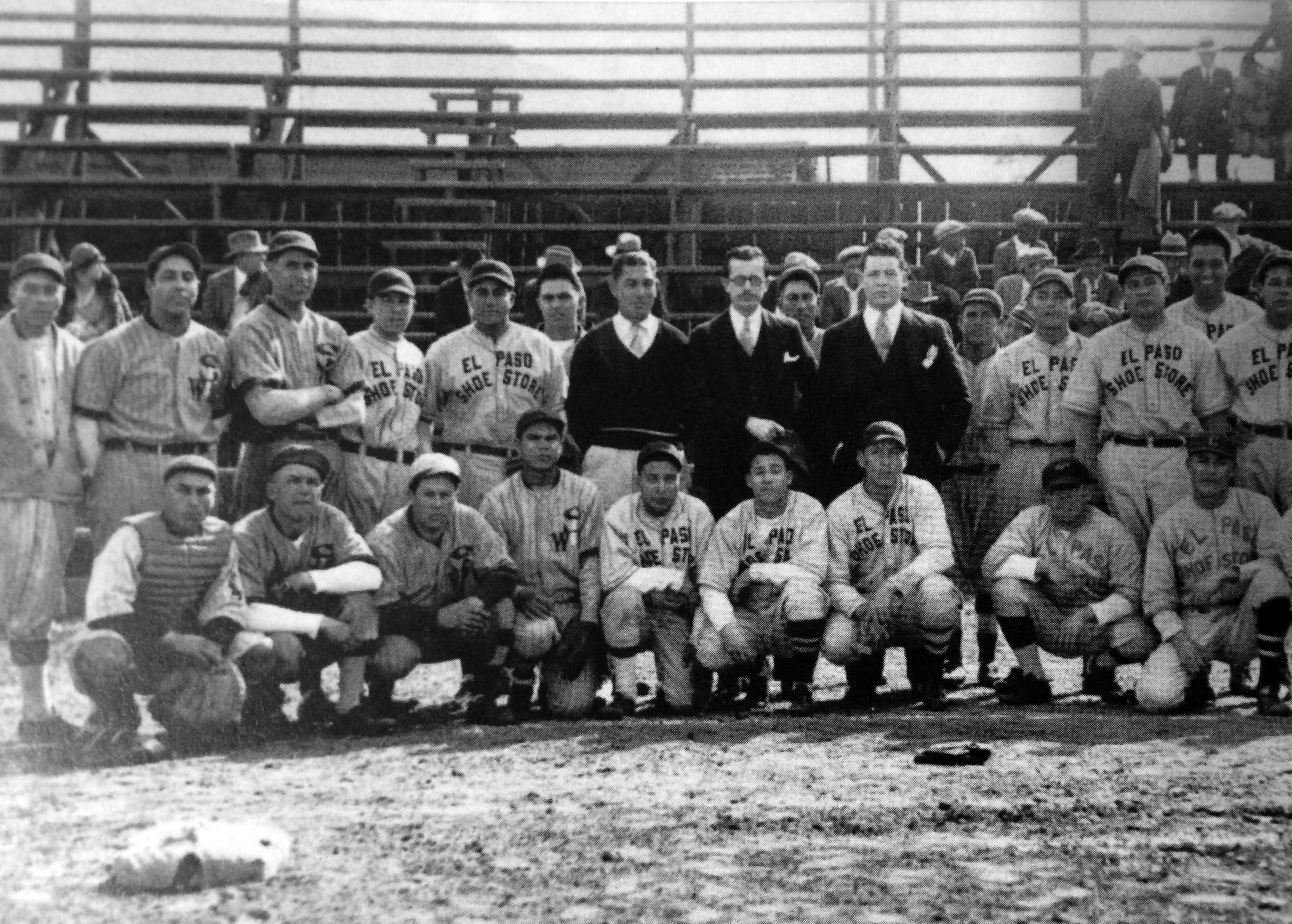 |
|
| (ca. 1930s)* – View showing the Los Zapateros team who played most of their games at White Sox Ball Park. The team sponsor's name is seen on the uniforms - El Paso Shoe Store. |
Historical Notes The Los Zapateros team was owned and managed by Don Rodrigo Castillo, who founded El Paso Shoe Store when he moved to Los Angeles from El Paso. Throughout the 1930s baseball teams from Mexico were invited to play against local Mexican American teams. Los Zapateros also played matches against the Los Angeles Nippons, a nisei baseball team. By the early 1940s the ballpark fell into disrepair and was demolished at the end of World War II to make way for veteran housing project and the Ross Snyder Recreation Center.* |
* * * * * |
Brookside Park (Pasadena)
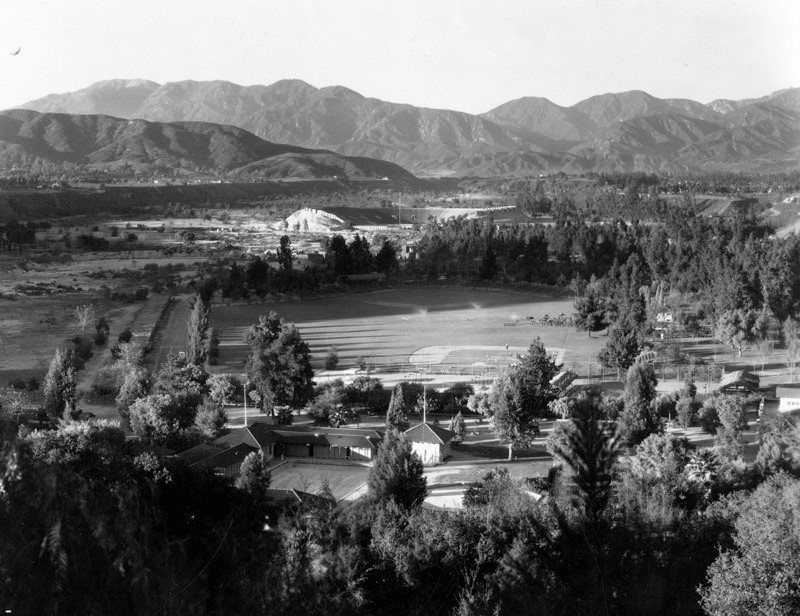 |
|
| (ca. 1930s)* - View showing the Brookside Park baseball field used by the Chicago White Sox during Spring Training. The Rose Bowl can be seen in the background. |
Historical Notes From 1933 to 1942 and from 1946 to 1950, the Chicago White Sox held their spring training in Brookside Park.^^ |
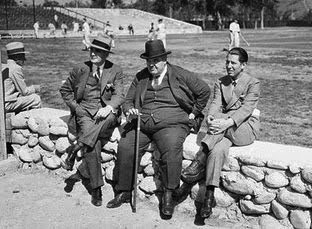 |
(1935)^^ - Joseph Barry, J. Louis Comiskey, William Wrigley Jr., and Harry Grabiner sit on an arroyo stone wall at Brookside Park while the Chicago White Sox play a baseball game during spring training. |
Historical Notes William Wrigley Jr. owned the Chicago Cubs and the team had its annual spring training on Catalina Island, which he owned. Joseph Barry was the White Sox traveling secretary, J. Louis Comiskey was owner and president of the White Sox organization and Harry Grabiner was vice president..^^ |
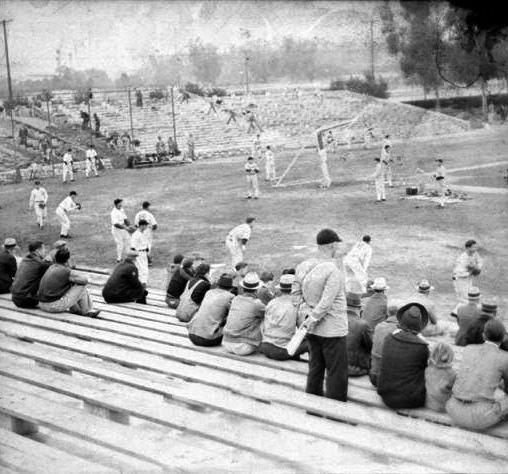 |
(1938)^^- Fans watch from bleachers at Brookside Park as the Chicago White Sox practice during Spring Training. | |
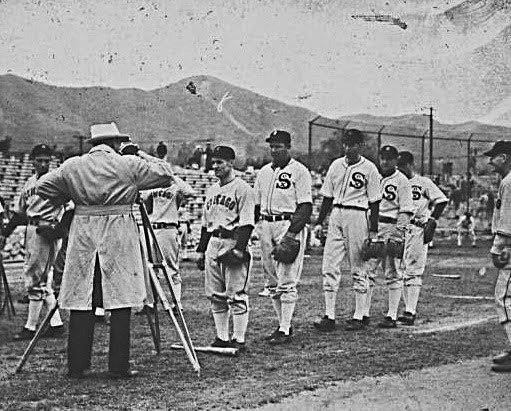 |
(1938)^^ - Chicago White Sox players line up in front of a movie camera for a newsreel that would be shown in theaters. (Brookside Park, Pasadena) |
|
* * * * * |
Wrigley Field (Catalina Island)
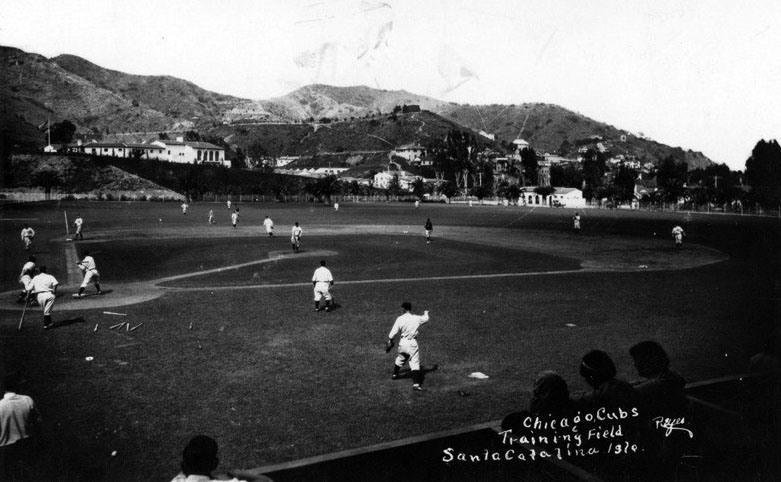 |
|
| (1920s)^*# - Spring training baseball action at the Chicago Cubs’ Wrigley Field facility on Catalina Island. |
Historical Notes In 1919, William Wrigley, Jr. gained a controlling interest in the Chicago Cubs and in 1921 he made the decision to have the Cubs train on Catalinia. In doing so, he became the first baseball owner to bring a major league club out West for spring training, building a facility for the Cubs on Catalina that he humbly called “Wrigley Field.” (Regular-season major league baseball wouldn’t arrive on the West Coast until the Dodgers and the Giants made their moves west in the 1950s.)*^*^ |
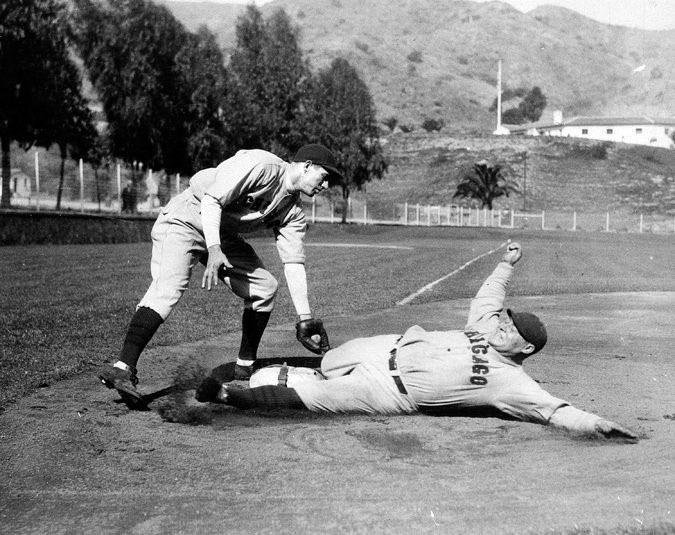 |
|
| (1929)## - Cubs outfielder Hack Wilson showed the team’s new third baseman, Footsie Blair, how to steal a base at Catalina Island. |
Historical Notes The Cubs were treated like royalty on the island, greeted with a parade each spring, fed at the ornate Hotel St. Catherine, and able to cavort with actresses like Betty Grable, Grace Bradley and Rochelle Hudson. They stayed at the Hotel St. Catherine in Descanso Bay and played on a ballfield built in Avalon Canyon that was named Wrigley Field. |
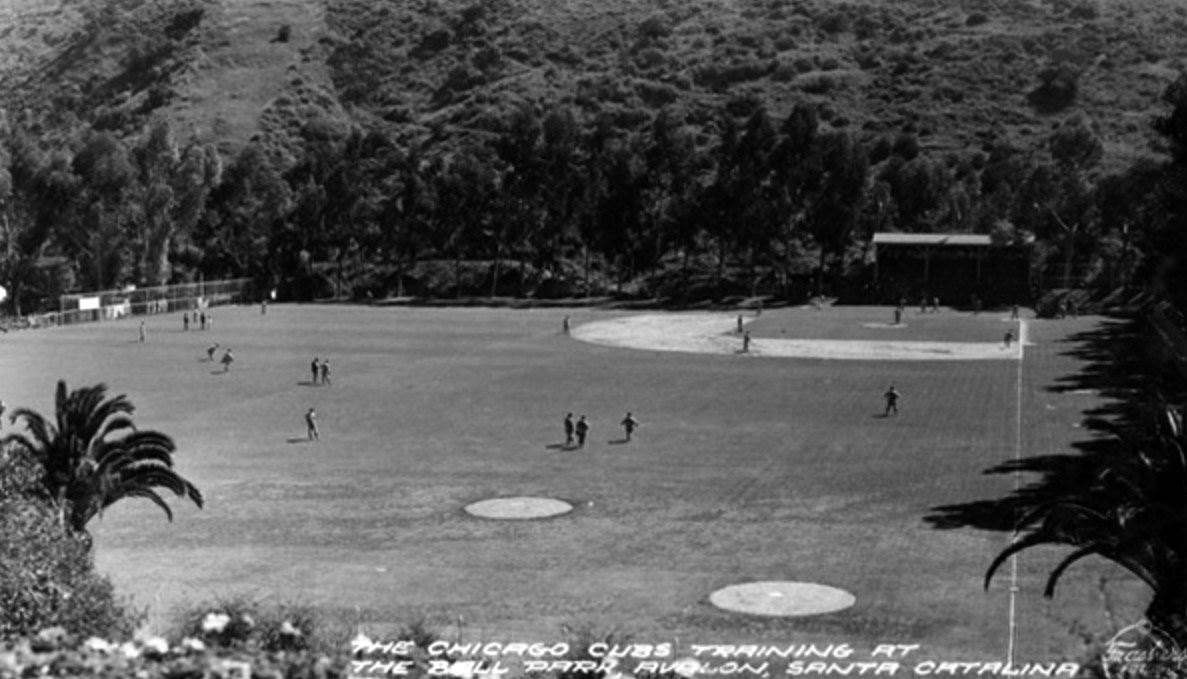 |
|
| (1940)**** - Postcard view showing the Chicago Cubs baseball team training at the Ball Park also called Wrigley Field in Avalon, Santa Catalina. |
Historical Notes Players stayed at the Hotel St. Catherine in Descanso Bay and played on a ballfield built in Avalon Canyon. The Cubs continued to use the island for spring training until 1951, except during the war years of 1942–45.*^ |
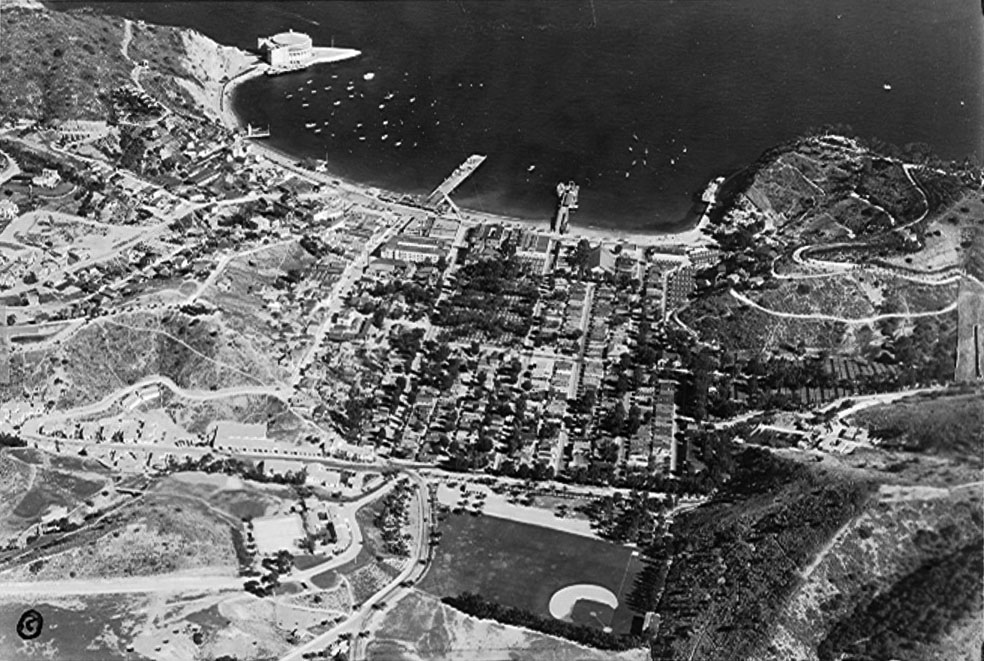 |
|
| (1930s)^**^ – Aerial view showing the town of Avalon. Wrigley’s Chicago Cubs spring training field (Wrigley Field) is seen in the foreground. |
Historical Notes Today, only a plaque noting the location of "Wrigley Field" remains on the grounds of what is currently the Catalina Island Country Club, though its clubhouse is the same structure that Wrigley built for the Cubs.^*^ Click HERE to see more Early Views of Catalina. |
* * * * * |
Wrigley Field (Los Angeles)
Wrigley Field was built in South Los Angeles in 1925 and was named after William Wrigley Jr., the chewing gum magnate who owned the first tenants, the original Los Angeles Angels Pacific Coast League team. In 1925, the Angels moved from their former home at Washington Park (Los Angeles), which was also known as Chutes Park. Wrigley also owned the Chicago Cubs, whose home (Wrigley Field) is also named after him.*^ |
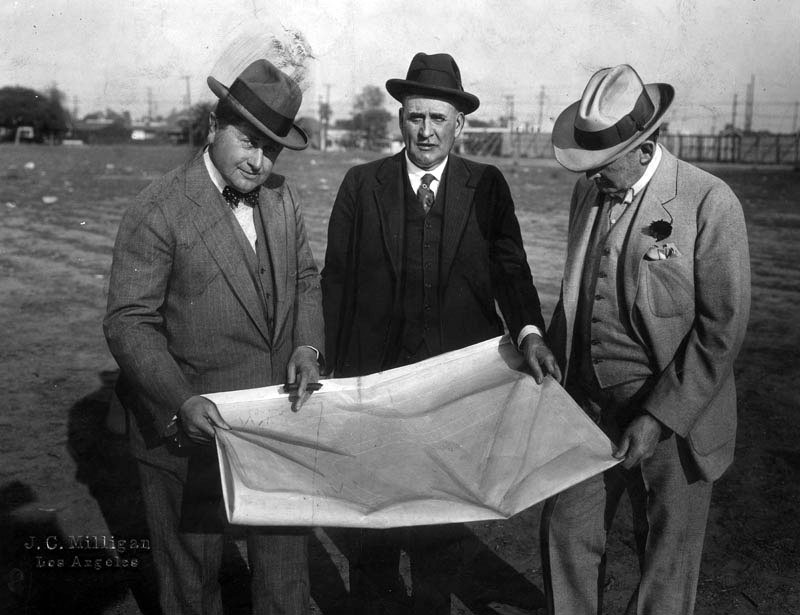 |
|
| (ca. 1924)* - William Wrigley Jr. (left) and partners look over blue prints for Wrigley Field. |
Historical Notes Chewing-gum magnate William Wrigley Jr. bought the Angels in 1921 as a farm team for his Chicago Cubs for the (then) astronomical sum of $150,000 and then built a stadium for the team a few years later. Construction for Wrigley Field began in 1924 and the stadium opened in 1925.* |
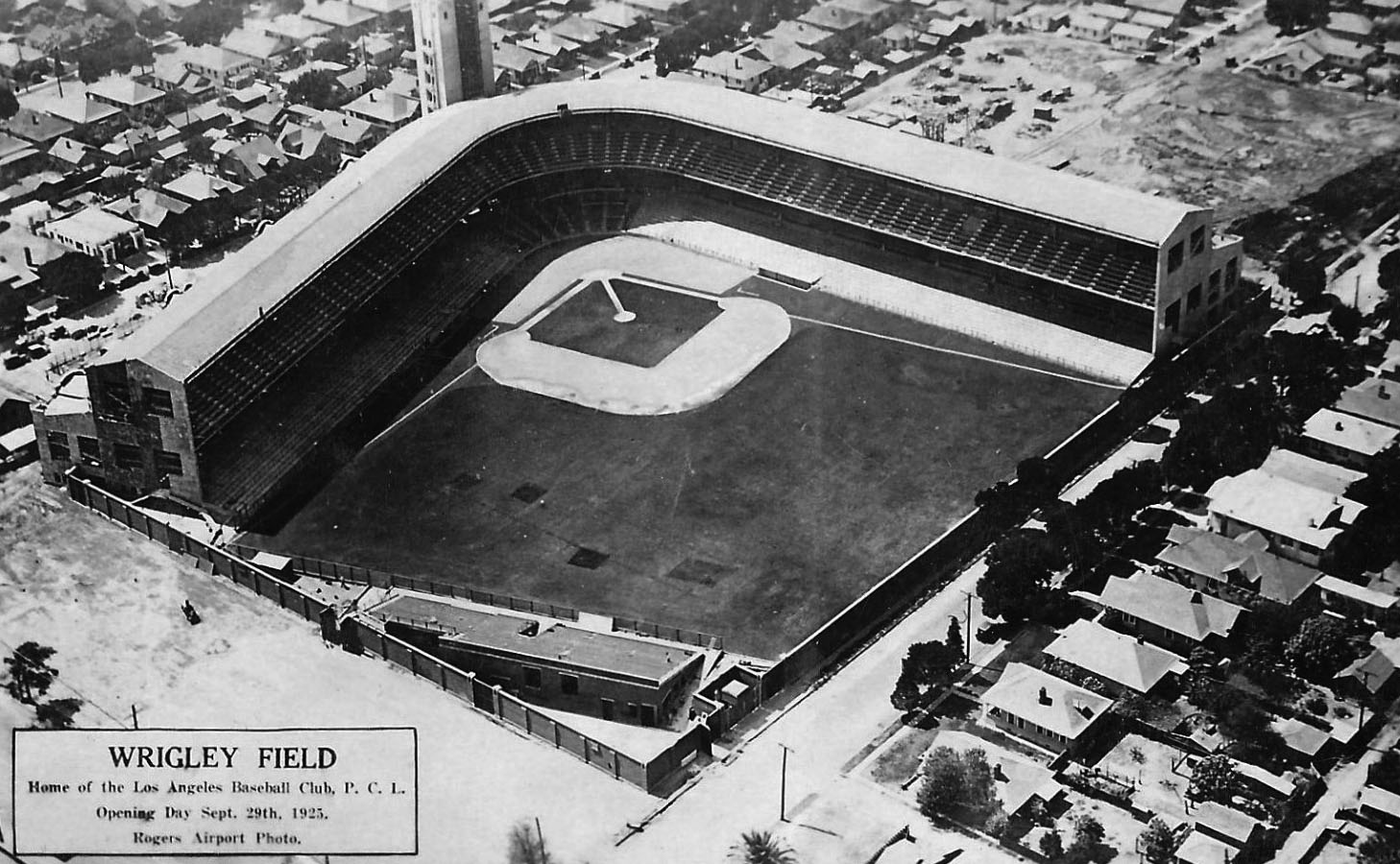 |
|
| (1925)^^* - View of Wrigley Field on opening day, September 29, 1925, as seen before the stadium was filled. |
Historical Notes For 33 seasons (1925-1957) Wrigley Field was home to the Angels, and for 11 of those seasons (1926-1935 and 1938) it had a second home team in the rival Hollywood Stars. The Stars eventually moved to their own new ballpark, Gilmore Field. Prior to 1925, the Angels played at their former home at Washington Park, and before that, at Chutes Park.* |
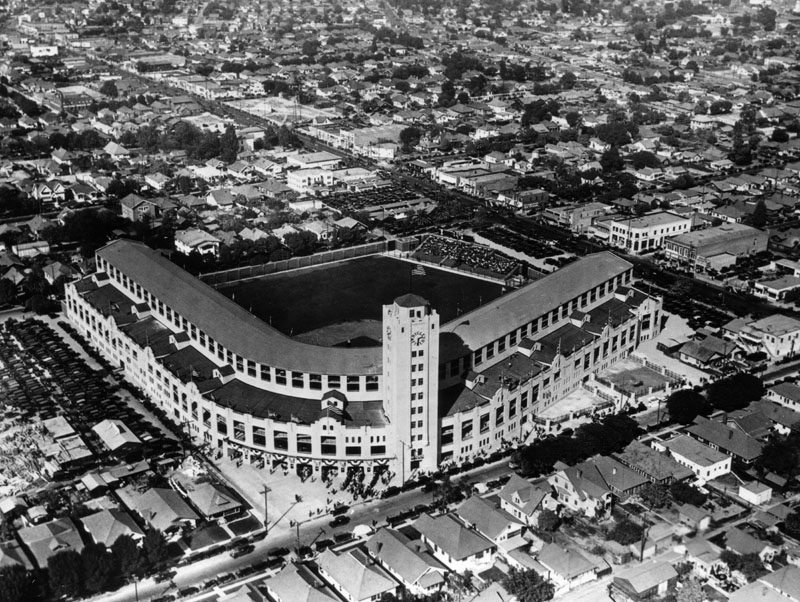 |
|
| (1925)* - Aerial view of Wrigley Field, Opening Day, September 29, 1925. |
Historical Notes The Los Angeles Wrigley Field was built to resemble Spanish-style architecture and a somewhat scaled-down version of the Chicago ballpark (known then as Cubs Park) as it looked at the time. It was also the first of the two ballparks to bear Wrigley's name, as the Chicago park was named for Wrigley over a year after the L.A. park's opening. At the time, he owned Santa Catalina Island, and the Cubs were holding their spring training in that island's city of Avalon (whose ballfield was located on Avalon Canyon Road and also informally known as "Wrigley Field"). Coincidentally, one of Wrigley Field's boundary streets was Avalon Boulevard (east, behind right field and a small parking lot). The other boundaries of the block were 41st Street (north, behind left field), 42nd Place (south, behind first base), and San Pedro Street (west, behind third base and a larger parking lot). Not only did L.A. Wrigley get its name first, it had more on-site parking than the Chicago version did (or does now).*^ |
 |
|
| (1925)^ - Opening day, Wrigley Field, 42nd Place and Avalon Blvd., Los Angeles, CA, 9/29/1925. |
Historical Notes The inaugural game was won by the Los Angeles Angels defeating San Francisco Seals, 10-8, before 18,000 fans. |
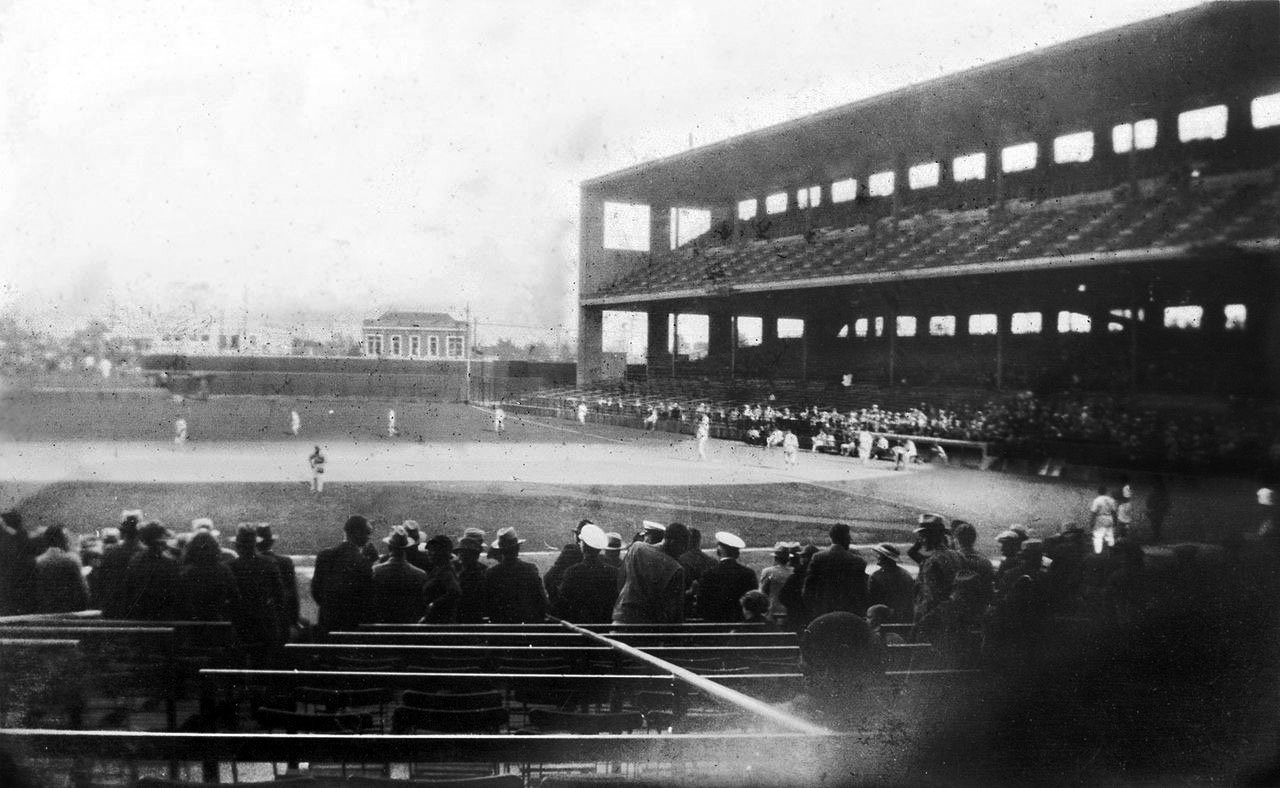 |
|
| (1930s)*^ – View of Wrigley Field looking toward the right field stands as seen from the box seats behind 3rd base line. Photo by Lee Minor (1914–2009) |
Historical Notes Erected in 1925 at 42nd Place and Avalon Blvd., Wrigley Field was a 21,000-seat, home-run hitters paradise. It also doubled as the set for such films as "Pride of the Yankees", "Dam Yankees" and "Alibi Ike" and the "Home Run Derby" television show.* |
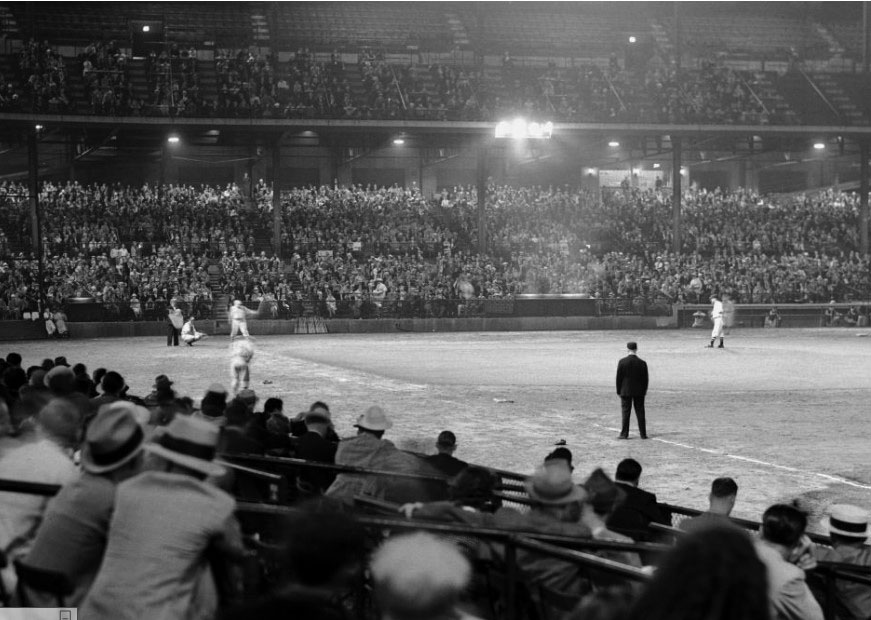 |
|
| (ca. 1930)*^* - Crowd watching a baseball game at Wrigley Field in South Los Angeles. Home of the Los Angeles Angels from 1925 to 1957. Also home of the Hollywood Stars from 1926-1935 and 1938. |
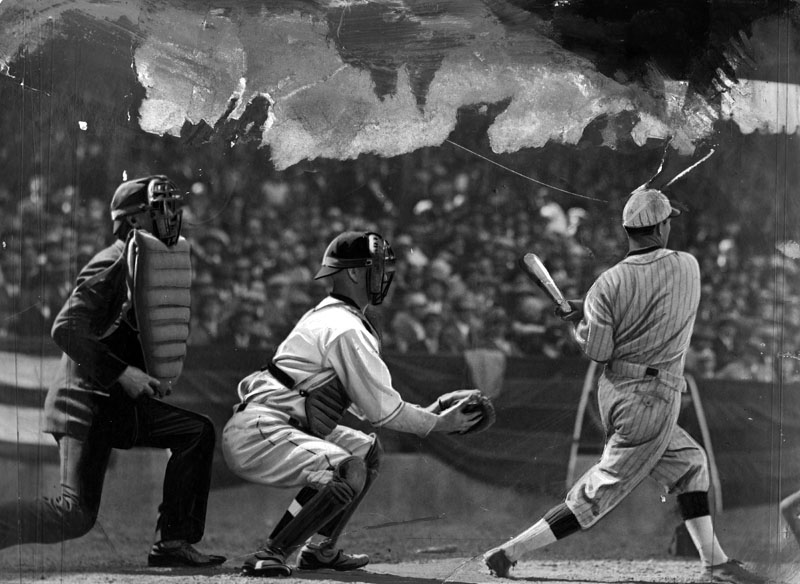 |
|
| (1930)* - The pennant chase is on. The Pacific Coast League gets down to serious business as Angels play at Wrigley Field. Photo dated: April 9, 1930. |
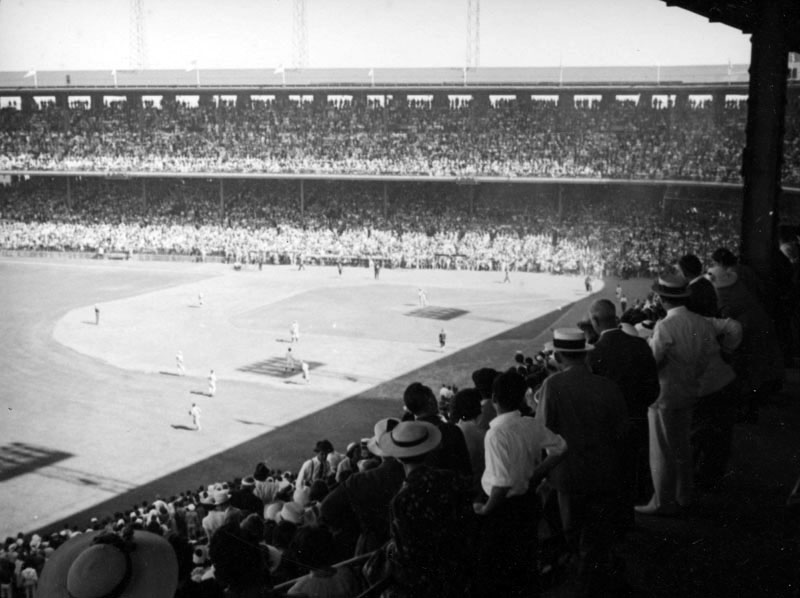 |
|
| (Early 1930s)* - Partial view of the "first" Wrigley Field - home for the Los Angeles Angels of the Pacific Coast League. The bleachers are practically bursting at the seams with eager spectators cheering on their favorite teams. |
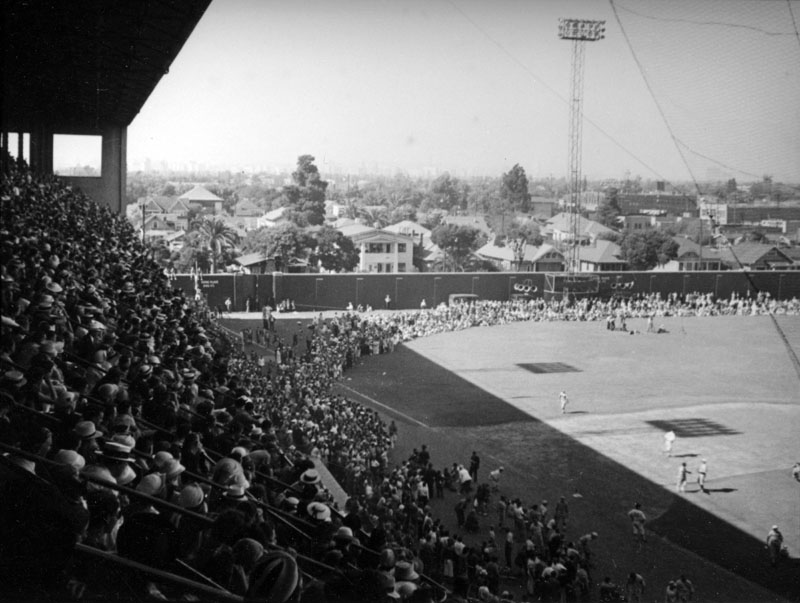 |
|
| (Early 1930s)* - The "first" Wrigley Field. The double-decked grandstand extended from the left field foul pole to home plate, and around to the right field foul pole. Bleachers and a scoreboard were located in right field. There was no seating in left field, just a 15-foot-high concrete wall (seen here), though it offered little to no protection for the houses located directly behind it, as they were constantly getting pelted with flying homeruns. The left field concrete wall was later covered in ivy as was its big "brother" Wrigley Field in Chicago. |
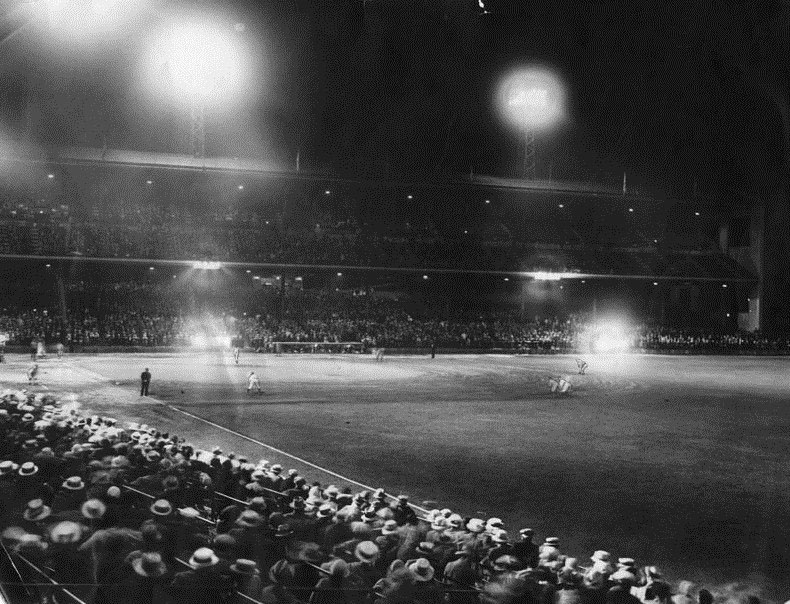 |
|
| (1930)* - The first night game in Los Angeles, at Wrigley Field. Chicago's Wrigley Field wouldn't get lights until 1988. Photo dated: July 22, 1930. |
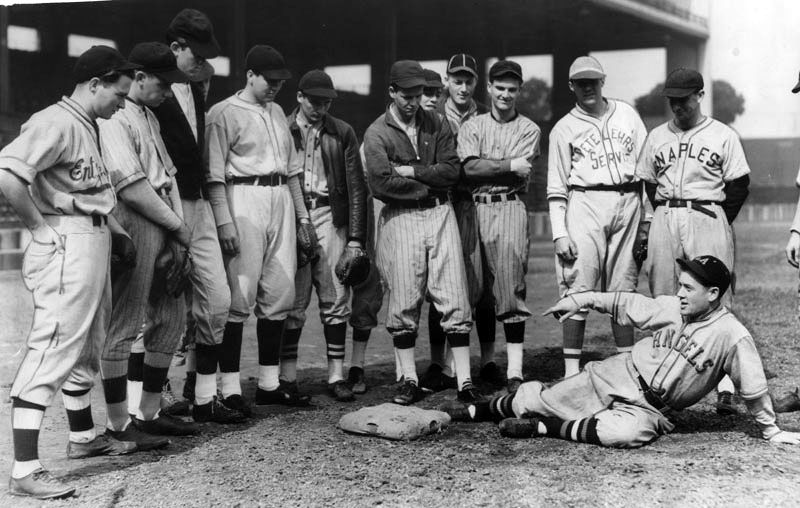 |
|
| (ca. 1935)* - The Angels won 14 PCL pennants, but their best team was the 1934 powerhouse (137-50), led by Triple Crown winner Frank Demaree and Arnold "Jigger" Statz (demonstrating sliding technique). Dubbed the "Greatest Angel of Them All," Statz was an excellent defensive centerfielder who cut a hole in the palm of his mitt to get a better feel for the ball. Statz played 18 seasons in L.A. and owns most of the PCL records (including games played, hits, and runs). Spanning his entire pro career, Statz compiled the most at-bats in baseball history. |
 |
|
| (ca. 1935)* - Fay Thomas (left, with Ray Prim), the ace of the Angels staff in 1934 with a 28-4 record. A USC grad who played collegiate football with actor John Wayne, Thomas played Christy Mathewson in "Pride of the Yankees." |
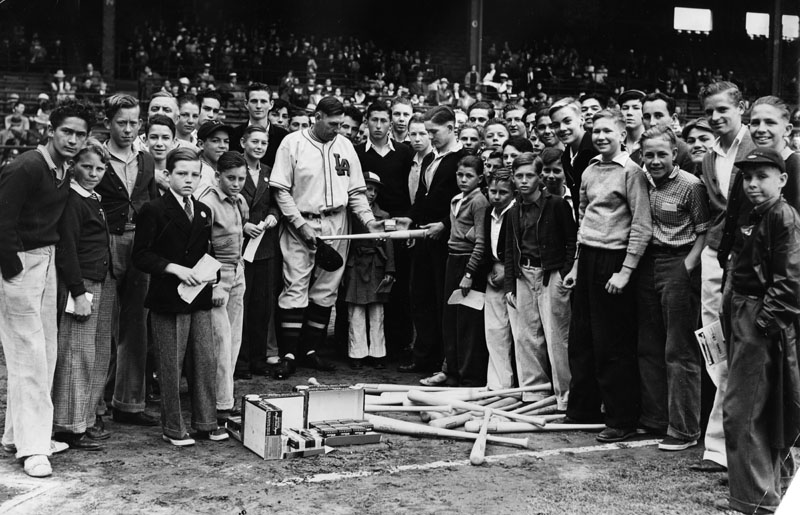 |
|
| (1937)* - Clustered around "Truck" Hannah, manager of the Los Angeles Angels, are a group of 50 excited youngsters who ran off with the prizes in the technical baseball contest, ready to receive their rewards from the Angel pilot. |
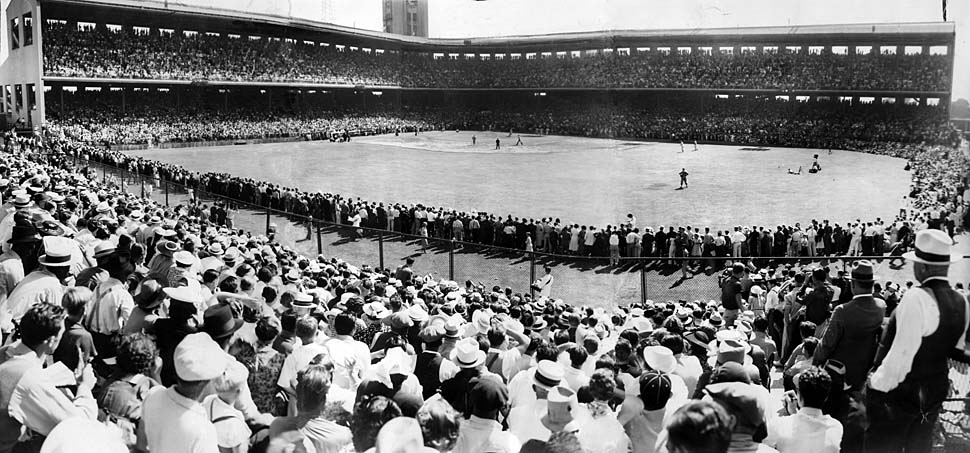 |
|
| (1937)*^^ - More than 30,000 fans crowd the 22,000-seat Wrigley Field for a celebrity charity baseball game for Mt. Sinai Hospital. LA Times photo date: July 17, 1937. |
Historical Notes The Los Angeles Times caption reported the next day that “The overflow crowd was stationed in the outfield but no ground rules were necessary as none of the contestants was able to wallop the ball that far…” |
.jpg) |
|
| (1937)* - On July 17, 1937 two dozen celebrities played a baseball game for charity called the "second annual motion picture baseball game, comedians vs. leading men" at Wrigley Field. For the dramatic team Robert Taylor captained a team that included: Tyrone Power, Spencer Tracy, Clark Gable, Ray Miland, and Boris Karloff among others. The comedy team captained by Joe E. Brown included the Ritz brothers, Edie Cantor, Buster Keaton and Burns and Allen among others. This view of the game includes the stands, a film crew set up behind home plate, and a little bit of the diamond. |
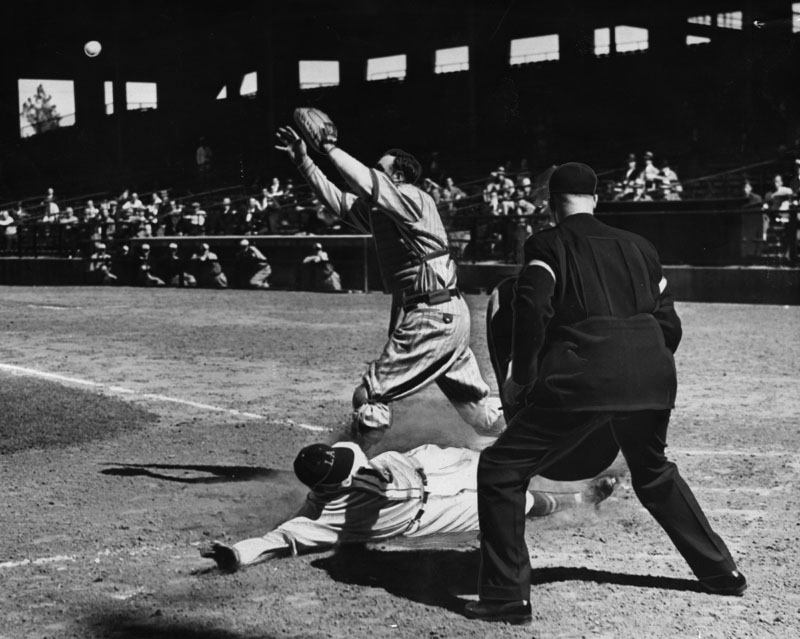 |
|
| (1937)* - "Jigger" Statz slid safely home on an infield hit by Carl Dittmar in the first inning of yesterday's ball game at Wrigley Field, and here the camera catches a wild throw from McDonald to Catcher Wilson of the Portland club. McWilliams also came home on the wild throw. But the Portland Beavers rallied to win the game in the later stages, so the effort went for naught. |
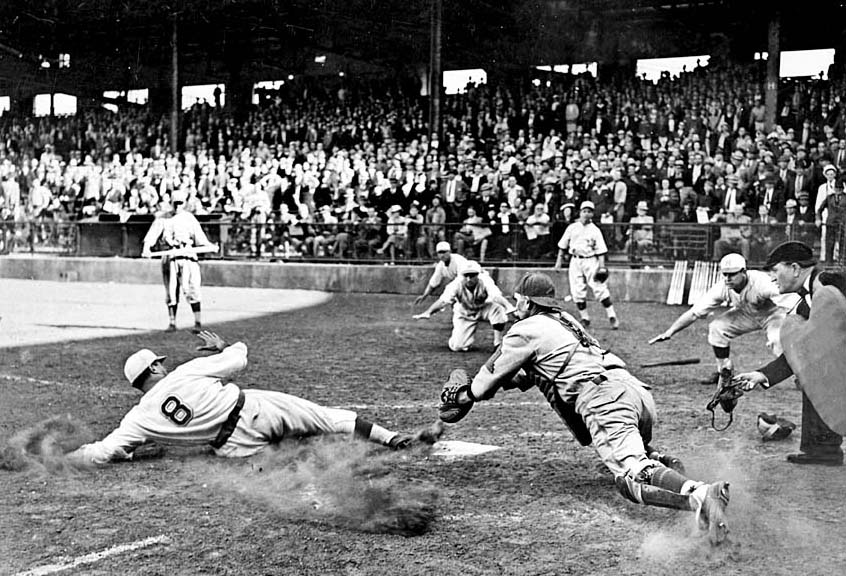 |
|
| (1938)*^^ - Frenchy Uhalt, Hollyood Stars leftfielder, had plenty of moral support as he slid across plate in ninth inning with run that beat the San Francisco Seals, 4-3, in the double hitter opener at Wrigley Field yesterday. Uhalt scored from second on Tom Carey's single, barely beating Brooks Holder's throw to catcher Larry]Woodall, shown diving as Frenchy's toe flicks a corner of the plate. Note [Chink] Outen, [Fern] Bell and [Bill] Norman, Stars in background, making the "safe" signal. The umpire is Henry Fanning. |
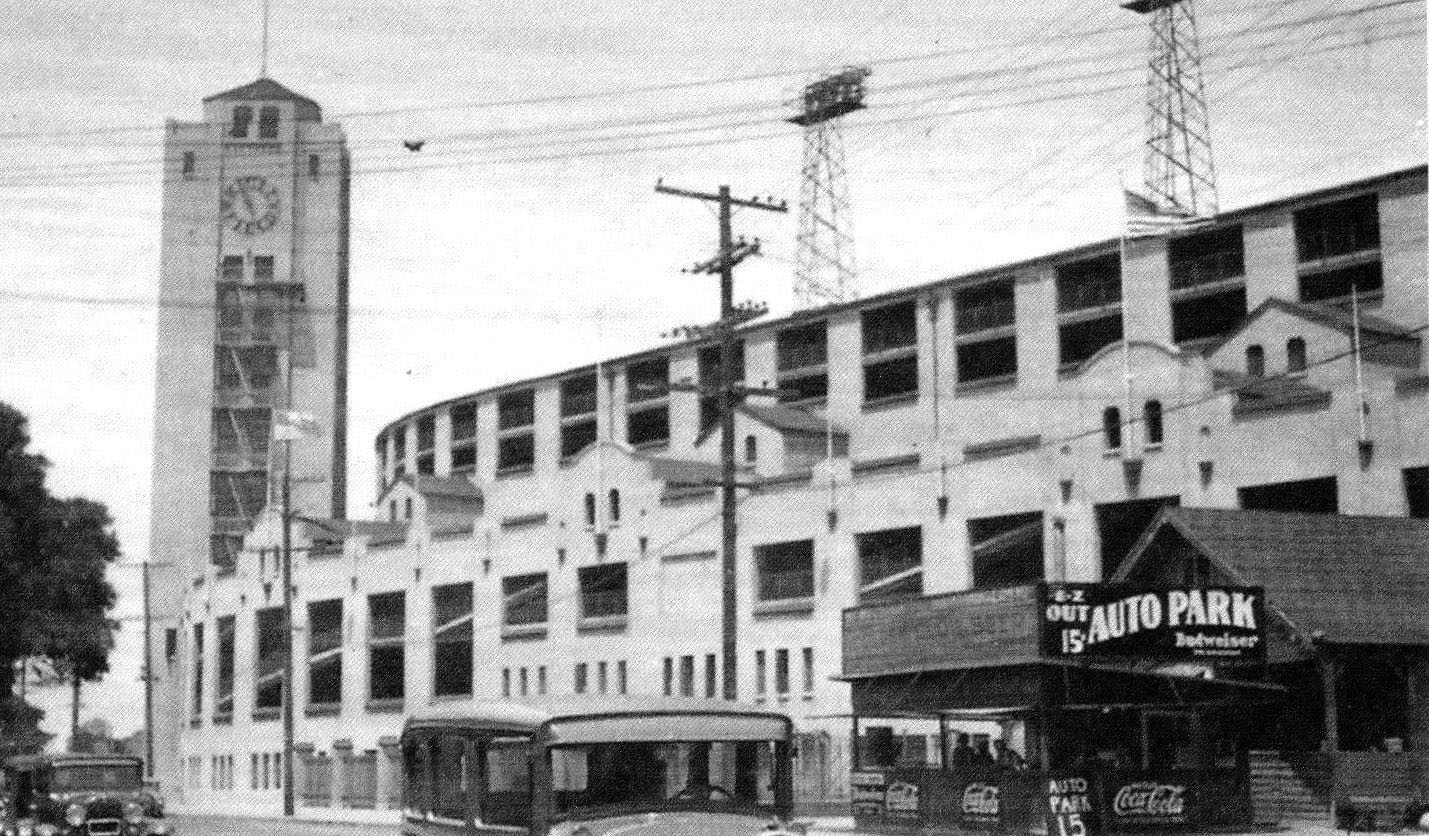 |
|
| (1930s)^.^ – Exterior view of Wrigley Field with its multi-story clock tower on the left. A concession stand is seen in the foreground with large sign reading: Auto Park 15¢ |
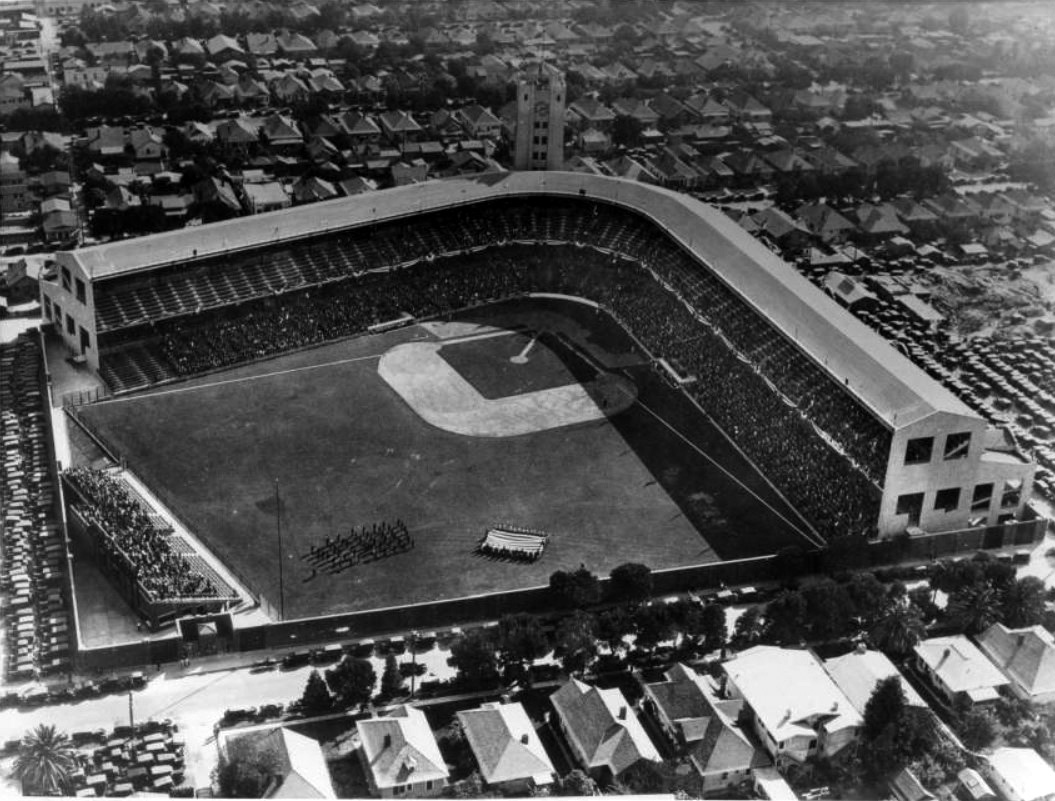 |
|
| (ca. 1940)^ – Aerial view showing Wrigley Field at pre-game ceremony. An American flag being supported by four lines of people can be seen below the diamond. A group of people stand in rows to the left of the flag while the lower levels of the stadium are visibly full. The clock tower behind the stadium shows the time at 2:40 in the afternoon. |
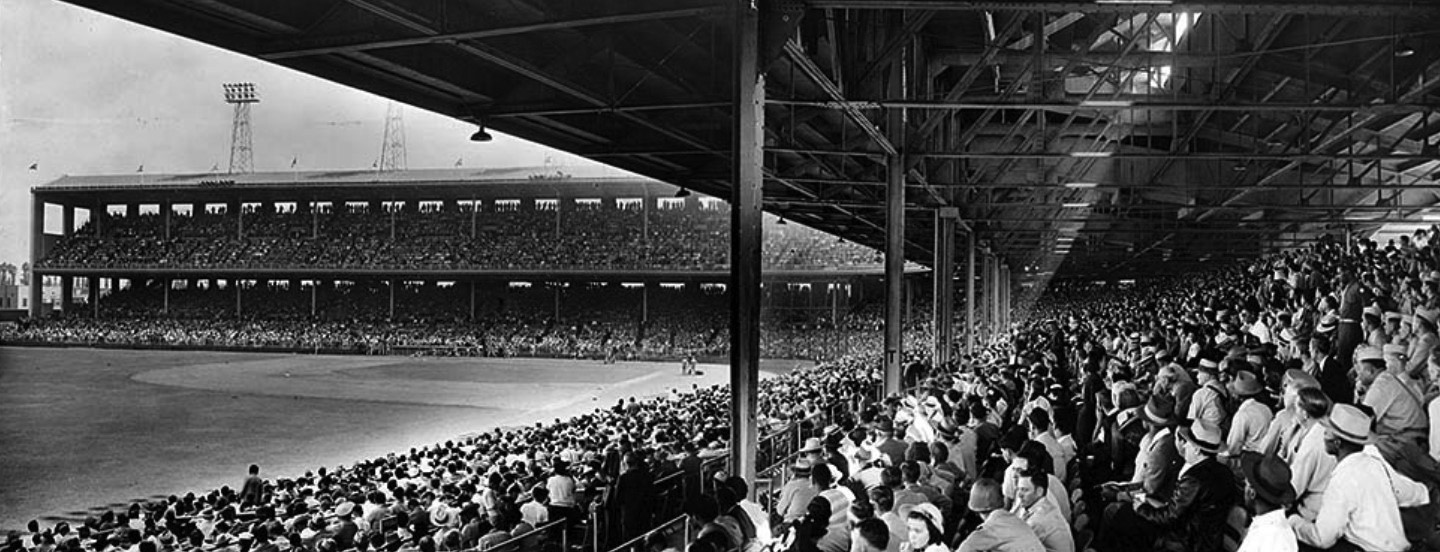 |
|
| (1943)*^^ - A turnout of 21,742 paying fans attended a benefit game between major league stars, led by Joe DiMaggio, and a team composed of Hollywood Stars and Los Angeles Angels players. The major leaguers won 8-2. This two-photo panorama of Wrigley Field was published in the Aug. 22, 1943, Los Angeles Times |
 |
(1951)* - Chuck Connors, baseball player for both the Angels and the Hollywood Stars. During his short baseball career, 1949 - 1951, Conners also played on the Brooklyn Dodgers and Chicago Cubs.
|
Historical Notes Chuck Connors, made a successful move from one side of the box seat railing to the other, becoming the star in "The Rifleman", a popular 1950's TV show.* |
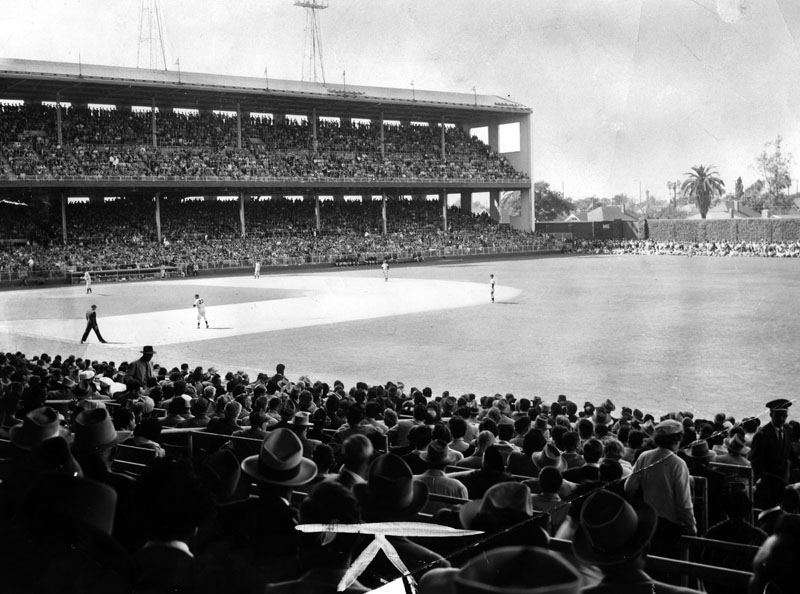 |
|
| (1955)* - Another full house at Wrigley Field to watch their home team the Angels. Note the left field wall is now covered in ivy. |
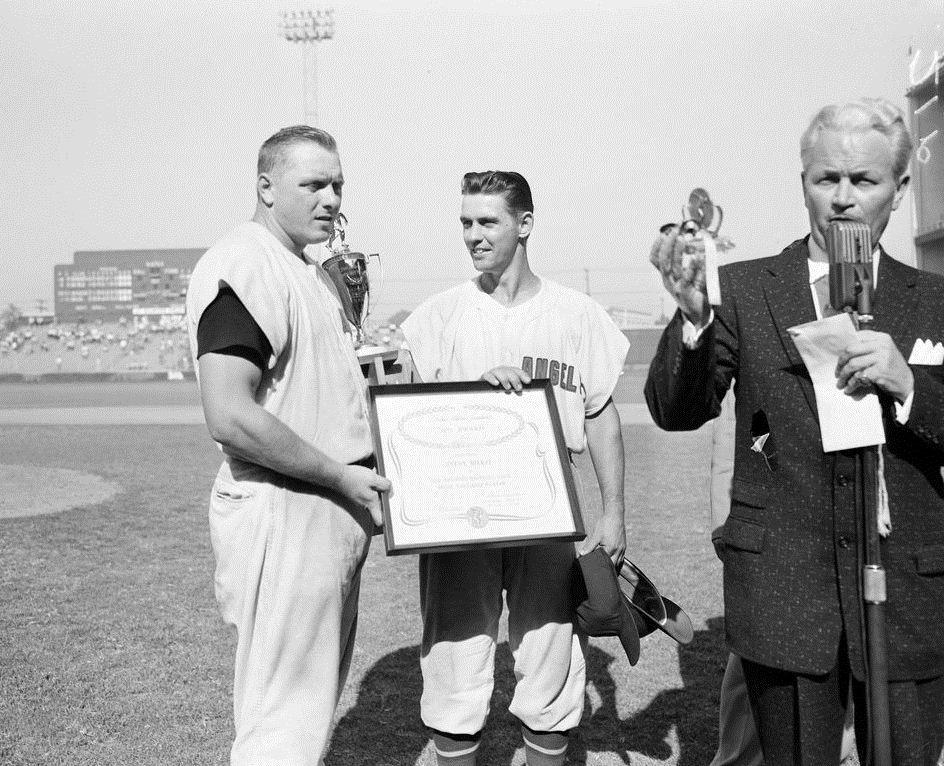 |
|
| (1956)^ - Steve Bilko receives 'Most Valuable Player Award' from Gene Mauch. |
Historical Notes In 1956 Steve Bilko had a notable achievement. That year he won the Triple Crown with stats (Home Runs, RBI's, and Batting Average) exceeding that of Mickey Mantle, who also won the Triple Crown that same year in the American League. The 1956 Angels Club featured second baseman Gene Mauch. The "Little General" as he would be nicknamed years later, went on to become one of the winningest managers in Major League Baseball history. |
 |
|
| (1957)* - Steve Bilko (left), the Angels' greatest power hitter. From 1955-1957, the burly Bilko led the PCL in home runs; he won the Triple Crown in 1956, leading the Angels to the pennant. So popular was Bilko that comedian Phil Silvers named his most famous character, Sergeant Bilko, after the first baseman. To the right of Bilko is Dick Stuart, also of the Hollywood Stars. He was nicknamed "Dr. Strangeglove" for his defensive deficiencies. |
 |
|
| (1957)* - In 1957, Walter O'Malley traded his farm team, the Fort Worth Cats, and cash in exchange for the Los Angeles Angels and Wrigley Field, a deal that gave O'Malley territorial rights to L.A. Many fans assumed that he would move the Dodgers to Wrigley Field--home of the Angels--and architects drew up plans to boost seating capacity at the aged stadium. Instead, O'Malley decided to begin play in the renovated Coliseum. |
Historical Notes In February 1957, Phil Wrigley (heir son of William Wrigley), sold both the team and Wrigley Field to Walter O'Malley, owner of the Brooklyn Dodgers, for $3,000,000. The last Pacific Coast League game at Wrigley Field was played on September 15, 1957.* |
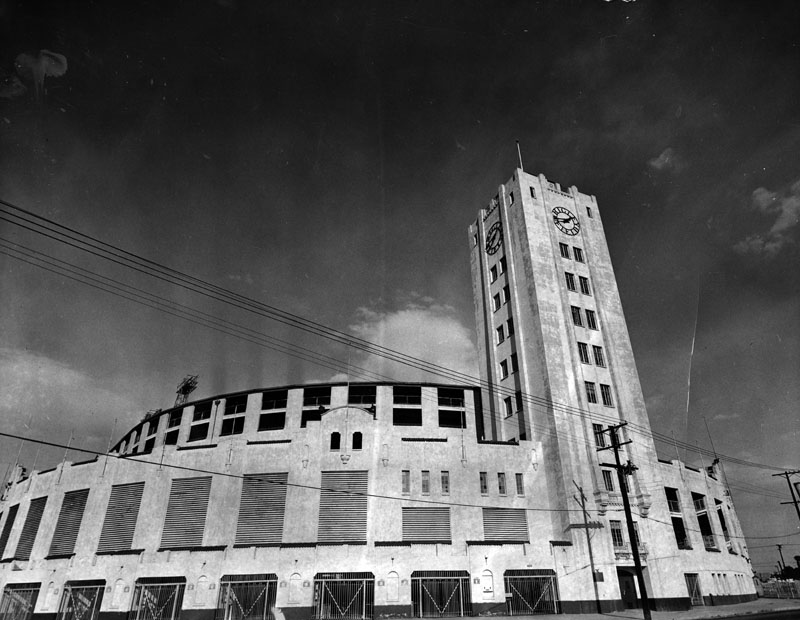 |
|
| (1960)* - Photograph caption dated December 8, 1960 reads, "Here's an exterior shot of Wrigley Field which will house the new Angel baseball team of the American League when it makes its local debut next year. The park, which has a present capacity of 22,500, may be expanded slightly. It is now city-owned, with 340 feet deep left field, 339 feet in right, and 412 feet deep in center. 'It's in good condition,' said officials." |
Historical Notes The Angels franchise of today was established in MLB in 1961 after former owner Gene Autry bought the rights to continue the franchise name from Walter O'Malley, the former Los Angeles Dodgers owner who had acquired the franchise from Phil Wrigley, the owner of the Chicago Cubs at the time. As stated in the book Under the Halo: The Official History of Angels Baseball, "Autry agreed to buy the franchise name for $350,000, and continue the history of the previously popular Pacific Coast League team as his own expansion team in the MLB." After the Angels joined Major League Baseball, some players from the Angels' PCL team joined the MLB Angels in 1961. |
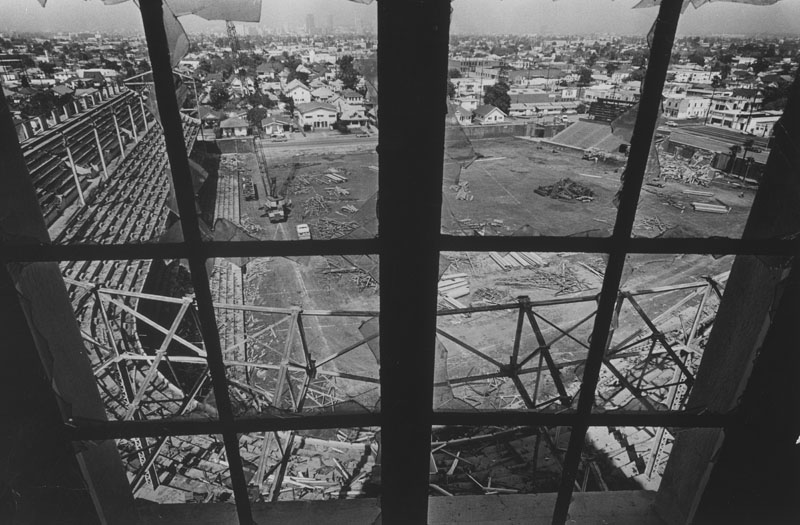 |
|
| (1966)* - Demolition of Wrigley Field. Photo dated: March 19, 1966. |
Historical Notes In 1961, the Los Angeles Angels joined the American League as an expansion team and took residence at Wrigley Field for just one season. The Angels then moved into Dodger Stadium with the Los Angeles Dodgers, until 1965. In 1966, the Angels moved into their own home, Anaheim Stadium. Sadly, with no minor league baseball teams left in the area, Wrigley Field was torn down in the mid 1960s; Gilbert Lindsay Park presently occupies the site.* |
* * * * * |
Gilmore Field (Home of the Hollywood Stars)
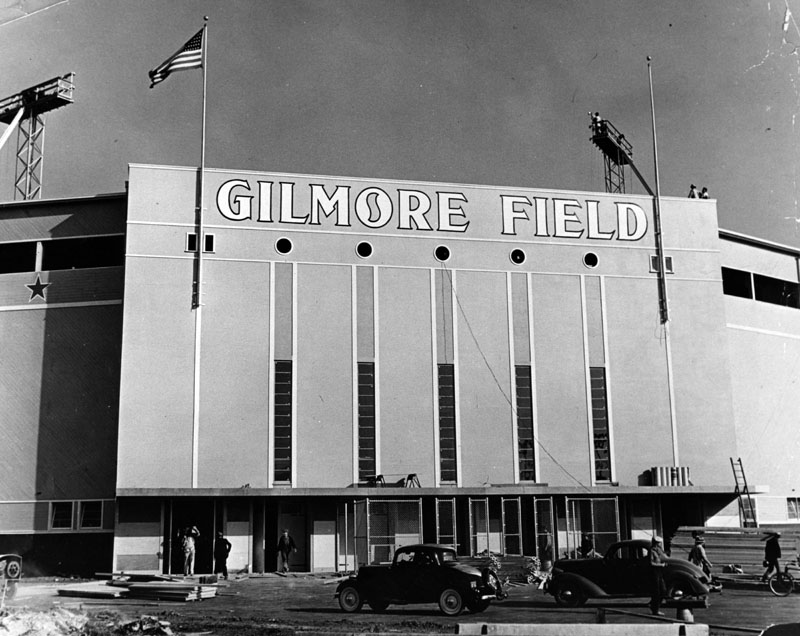 |
|
| (1939)* - Exterior view of the new Gilmore Field (Hollywood Ball Park). |
Historical Notes Gilmore Field opened on May 2, 1939 and was the home of the Hollywood Stars until September 5, 1957. The team that came to be known as the Hollywood Stars took a circuitous route on its way to Los Angeles. It began its existence in 1903 as the Sacramento Solons, a charter member of the PCL. The team moved to Tacoma in 1904, where it won the pennant as the Tacoma Tigers. During the 1905 season, the team returned to Sacramento to finish out the season, moved to Fresno in 1906 to finish last as the Fresno Raisin Eaters, then left the PCL altogether. The Sacramento Solons rejoined the PCL in 1909, then moved to San Francisco during the 1914 season, finishing out the season as the San Francisco Missions. The team was sold to Utah businessman Bill "Hardpan" Lane and moved to Salt Lake City for the 1915 season. They played as the Salt Lake Bees for the next eleven seasons until Lane moved the team to Los Angeles for the 1926 season. Originally they were known as the Hollywood Bees, but soon changed their name to the Hollywood Stars. After but one season, the team was sold to new owners, among them Bob Cobb of Brown Derby Restaurant fame and the inventor of the California Cobb Salad. In their salad days, as it were, the Stars attracted glamorous actors and other celebrities or anyone else who wanted to be "seen", much as Dodger Stadium would later.*^ |
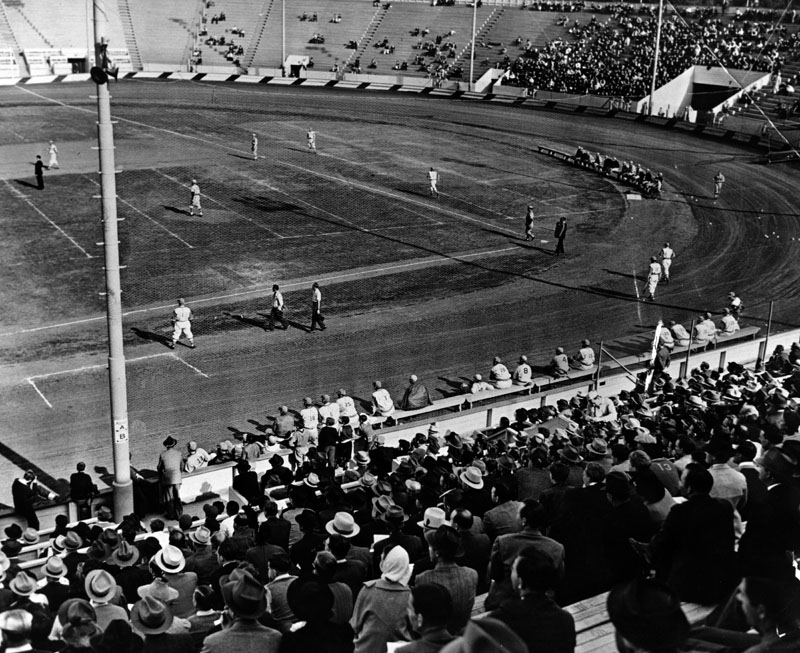 |
|
| (1939)* - The Hollywood Stars playing at the Gilmore Stadium prior to the completion of Gilmore Field. Photograph dated April 5, 1939 caption reads, "Here is a general view of the debut of Coast League baseball in Hollywood yesterday. Scene is of the Hollywood-Portland game, won by the Stars, 9-5. Crowd of 3500 turned out to watch the game." |
Historical Notes Built by Earl Gilmore, Gilmore Stadium opened in May 1934 and was demolished in 1952. The first professional football team in Los Angeles, the Los Angeles Bulldogs played at Gilmore. Before the neighboring Gilmore Field opened on May 2, 1939, the Hollywood Stars used Gilmore Stadium for their home games (apparently for only one month).* |
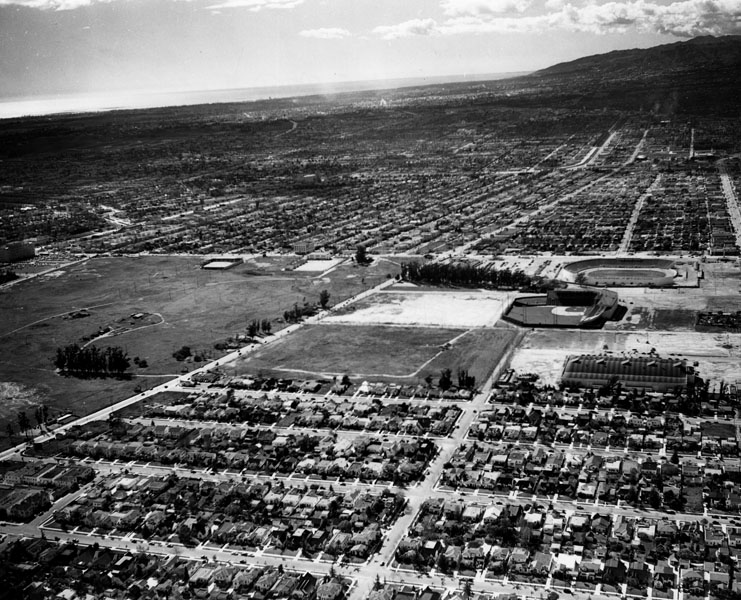 |
|
| (ca. 1939)* - Aerial view of Hollywood Ball Park (Gilmore Field) and Gilmore Stadium. This site later became Farmers Market and later The Grove shopping center, as well as CBS Television City. |
Hsitorical Notes The Gilmore Field ballpark was located on the south side of Beverly Boulevard between Genesee Avenue and The Grove Drive, just east of where CBS Television City is currently located. A couple hundred yards to the west was Gilmore Stadium, an oval-shaped venue built several years earlier, which was used for football games and midget auto racing. To the east was the famous Pan-Pacific Auditorium. Both facilities were built by Earl Gilmore, son of Arthur F. Gilmore and president of A. F. Gilmore Oil, a California-based petroleum company which was developed after Arthur struck oil on the family property. The area was rich in petroleum, which was the source of the "tar" in the nearby La Brea Tar Pits.*^ |
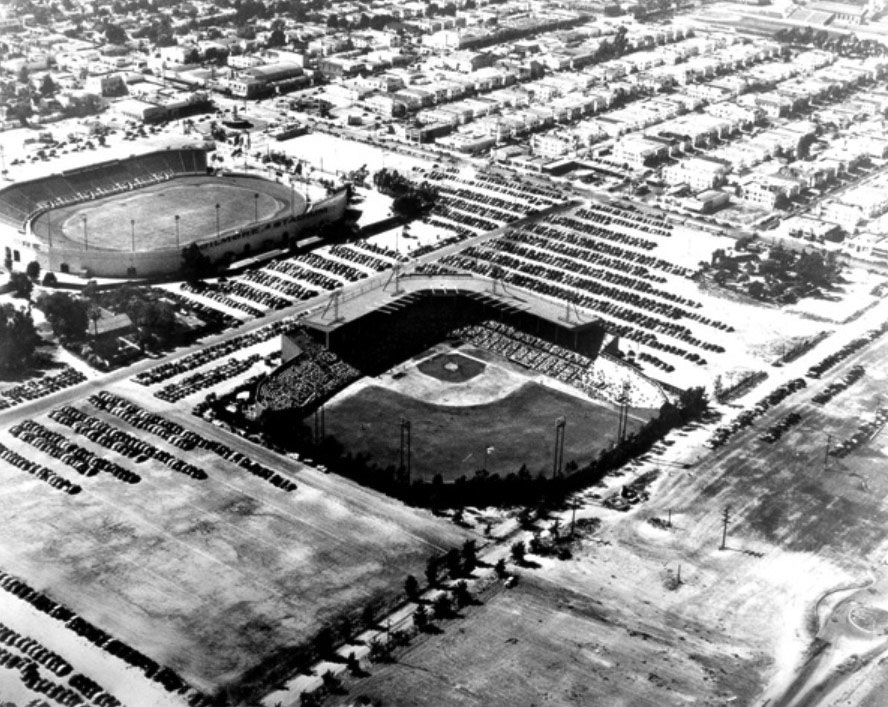 |
|
| (ca. 1939)^^^ – Aerial view looking northwest showing Gilmore Field. A baseball game is in progress and parking lots are close to full. An empty Gilmore Stadium stands in the background near Fairfax Avenue. Genesee Avenue runs diagonally from lower-left to right-center where it intersects with Beverly Boulevard. |
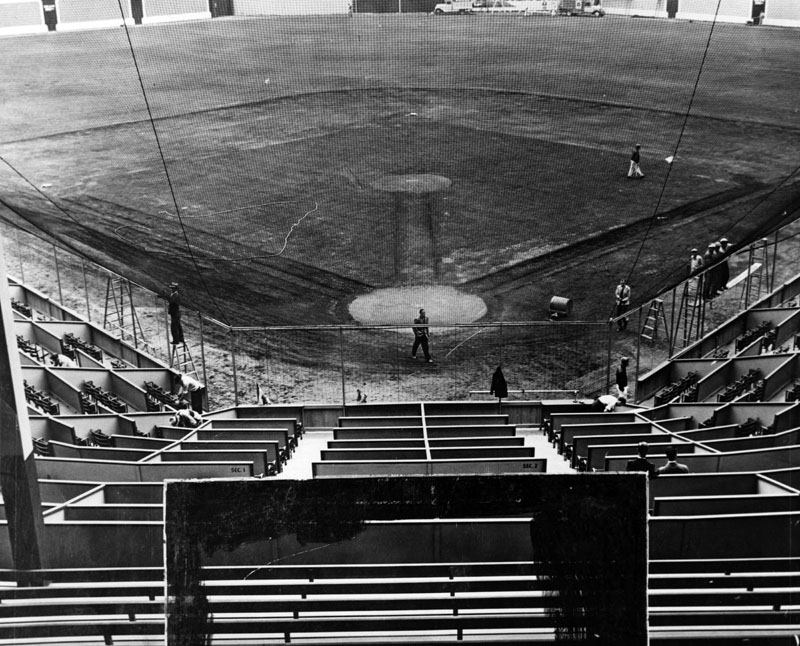 |
|
| (1939)* - On baseball's 100th anniversary, new park is christened in Hollywood today. Here's the shiny new diamond that greeted fans at Gilmore Field, home of Hollywood Stars, this afternoon when Stars opened series with Seattle. Note how close boxes are to the baselines. Photo dated: May 2, 1939. |
Historical Notes The field had intimate quarters from the spectator standpoint - first and third bases were 24 feet from the first row of seats. Home plate was 34 feet from the stands. The outfield gave the pitchers more of a break with foul lines 335 feet long, power alleys about 385, and 407 to center field. The power alleys were thus 40 feet deeper than in the cross-town counterpart, Wrigley Field.*^ |
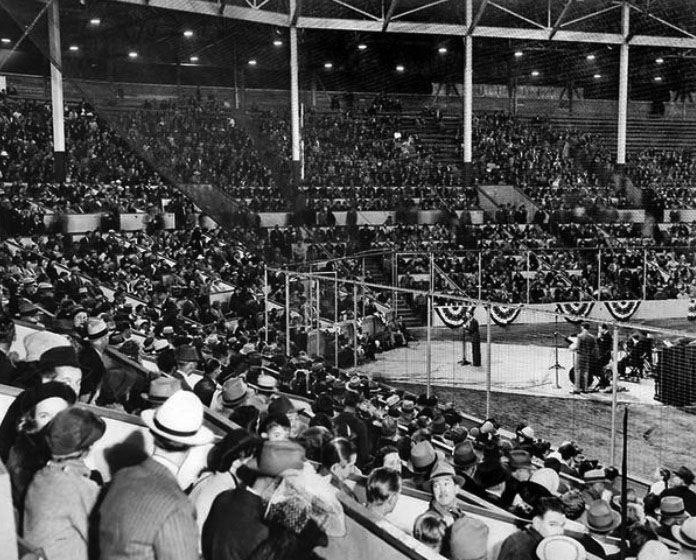 |
|
| (1939)#+ - Opening Ceremony for the 12,000 seat Gilmore Field on May 2, 1939. |
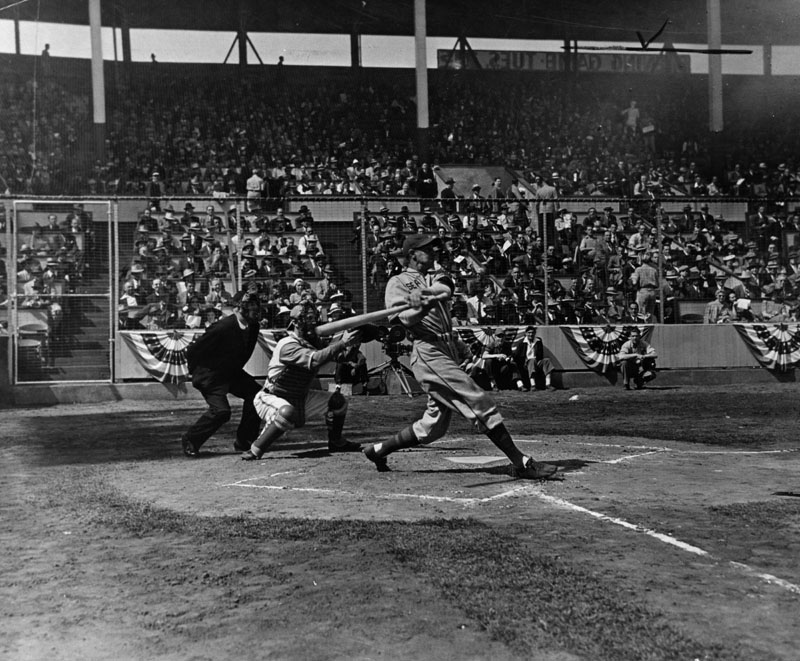 |
|
| (1939)* - Baseball went Hollywood today as the Stars opened their new park, Gilmore Field, before 10,000 fans and movie celebrities. Shown is Jo-Jo White, Seattle's outfielder as he flies out. Doc Crandall is the Stars' catcher. Photo dated: May 2, 1939. |
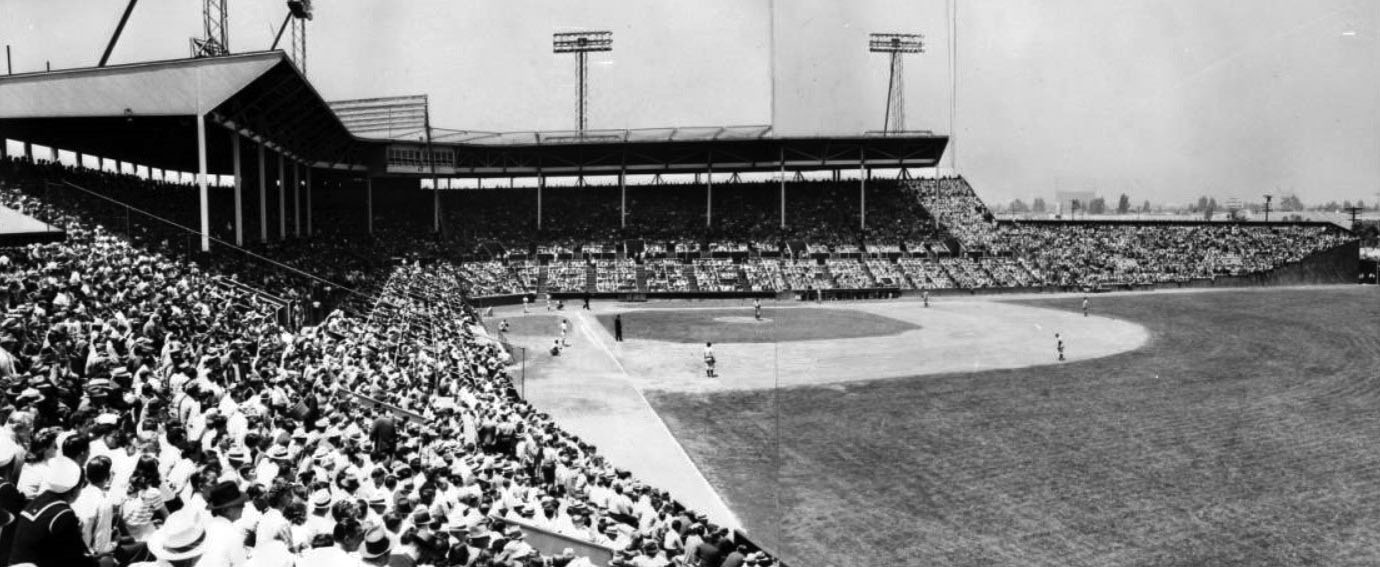 |
|
| (ca. 1939)^ - Panoramic view of Gilmore Field as seen from the seats in right field. |
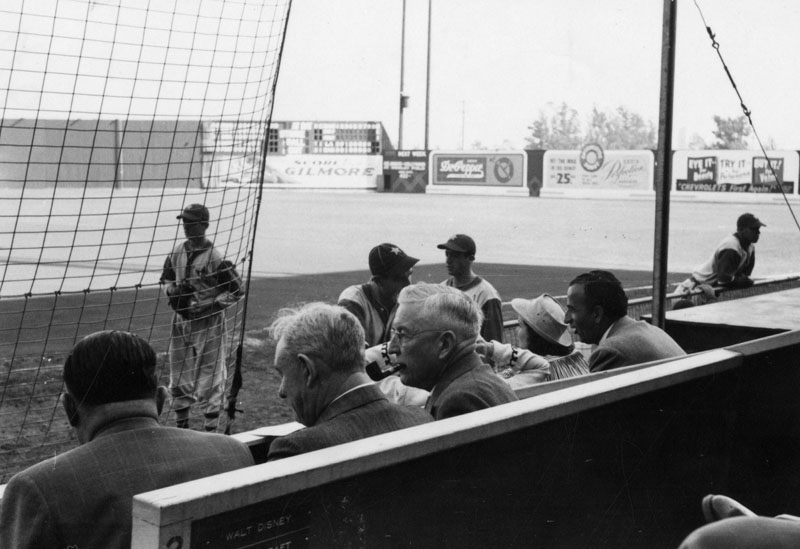 |
|
| (ca. 1940)* - Spectators are seen watching a baseball game in progress at Gilmore Field and Hollywood Ball Park, home of the Hollywood Stars team. The visiting team playing the Stars is unidentified. In the foreground behind the benches, name plaques read, "Walt Disney" and "George Raft", who must have been Stars fans. |
Historical Notes The team's owners realized the team needed to represent Hollywood in order to succeed. They sold stock in the team to movie stars, movie moguls, and Hollywood civic leaders ("the Hollywood Stars owned by the Hollywood stars"). One of these, Gene Autry, subsequently became owner of his own major league franchise, now the Los Angeles Angels of Anaheim. Another major investor was William Frawley from TV's I Love Lucy. Moreover, the team actually played in the Hollywood area, beginning in 1939 when 13,000-seat Gilmore Field was opened in the Fairfax District adjacent to Hollywood. The club played part of the 1939 season in nearby Gilmore Stadium, after having played at Wrigley Field during 1938.*^ |
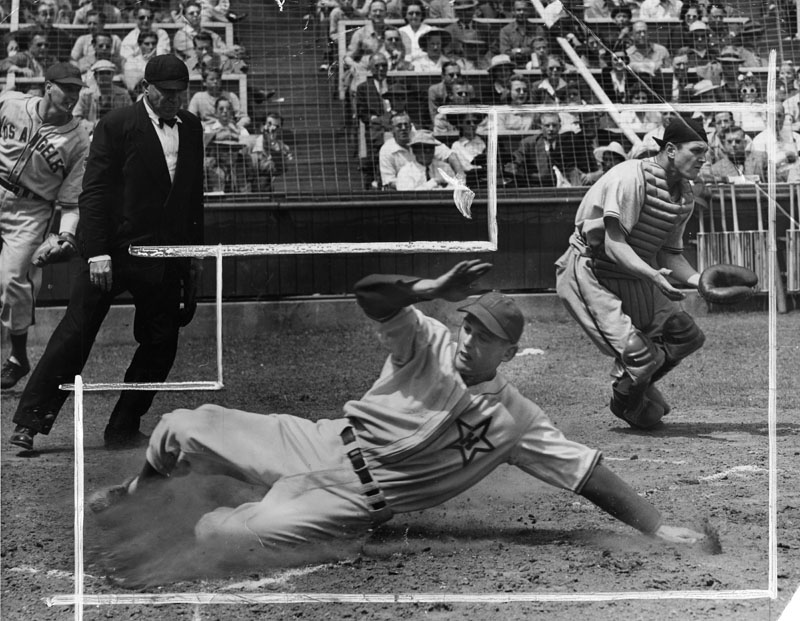 |
|
| (1942)* - There was action plus in the "Civil War" series between Los Angeles and Hollywood at Gilmore Field, as shown. Bill Garbe, Hollywood first baseman, slides safely home in the fourth frame of the first games which the Stars won, 13 to 1. Angel catcher Gilly Campbell prays for the ball. The Stars lost the second tilt, 6 to 4, but won the series 4 games to 3, with veteran Charlie Root the hero. Photo dated: May 11, 1942. |
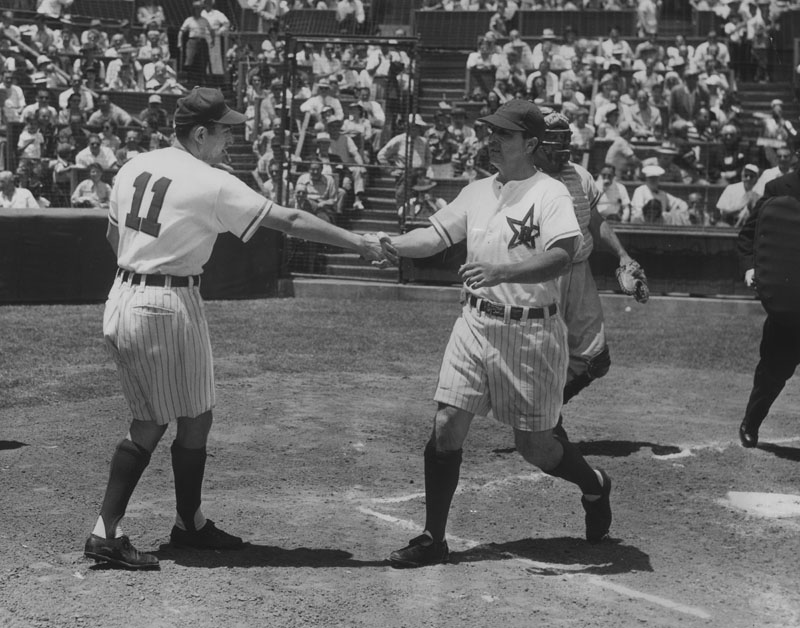 |
|
| (1950)* - Here, after hitting a home run, Frank Kelleher gets a congratulatory handshake from Herb Gorman. The stylish but impractical shorts lasted only a few seasons. |
Historical Notes The Stars had the dubious distinction of being the first team to replace the traditional bloused baseball trousers and stirrup socks with shorts and long socks in 1950. The theory was that players could run faster in this gear than in the baggy wool or cotton flannel uniforms of the day. The new uniforms resembling those worn by female softball players were "too Hollywood" even for Hollywood, as well as being very tough on the legs when sliding. They were soon replaced. The new Stars (or “Twinks”) caught on and became a very popular team, winning three pennants before 1958. They had successful affiliations with the Brooklyn Dodgers and Pittsburgh Pirates of Major League Baseball. In 1955, actress Jayne Mansfield was named Miss Hollywood Star. The Stars became genuine rivals of the Angels, and it was not uncommon for fights between the teams to break out during Angels-Stars games. In fact, on August 2, 1953, a brawl between the two teams lasted 30 minutes, broken up only when 50 riot police were sent to Gilmore Field by Chief of Police William Parker, who was at home watching the game on television when the fight started.*^ |
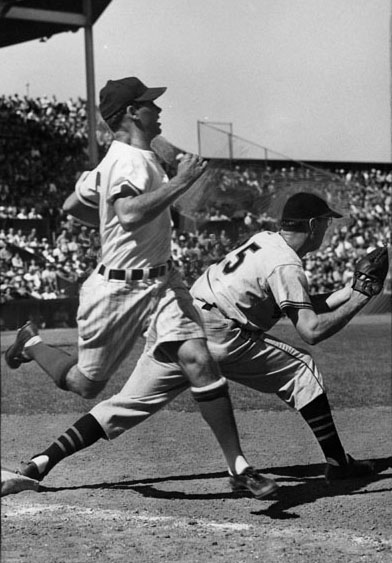 |
(1950)* - Buddy Hicks, Hollywood, is nipped at first in a close play in yesterday's first game as the Twinks beat San Diego in a double header. Jack Graham is the Padre first sacker.
|
|
 |
|
| (1950)*^* - Jim Baxes batting during Hollywood Stars vs. San Francisco Seals game. |
Historical Notes LA Times Published Caption: "TAIN'T FUNNY--When Seal Hurler, Chet Johnson sizzled his first pitch behind Jim Baxes' back to mimic Jim's wildness, he got a big laugh. But it wasn't so funny when Johnson's next pitch, this steaming curve, caught Baxes in middle of back in eighth inning. Seals won 13-3." *^* |
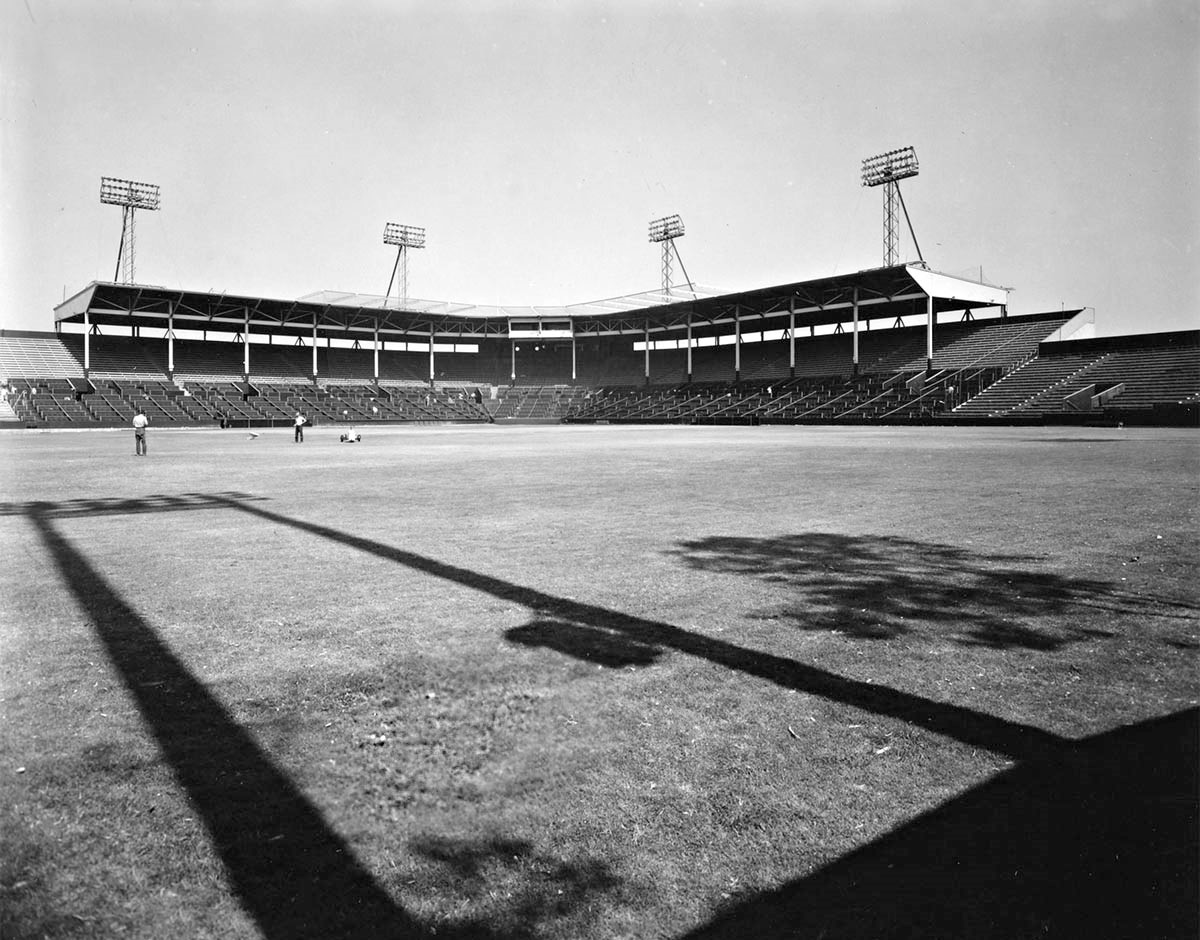 |
|
| (1949)*++ – View of a nearly empty Gilmore Field before start of a game. Photo by Julius Shulman |
.jpg) |
|
| (1949)*++ – Pre-game view from edge of the grandstands at Gilmore Field. Photo by Julius Shulman |
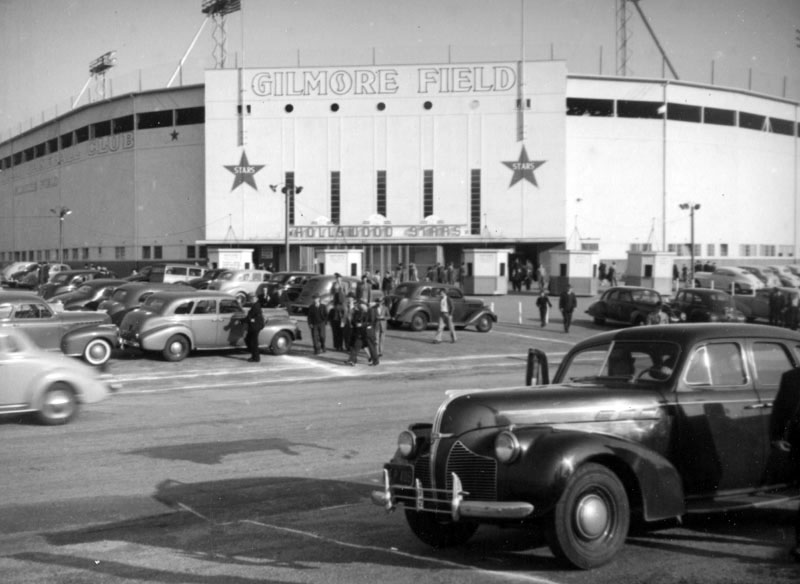 |
|
| (1940s)* - View showing Gilmore Field (aka Hollywood Ball Park), located near the present-day Farmer's Market in the Fairfax District. This was home field of the Hollywood Stars. The parking lot appears full and there are clusters of people walking out of the main entrance. |
 |
|
| (1940s)^ - Closer view of the entrance to Gilmore Field….Home of the Hollywood Stars. |
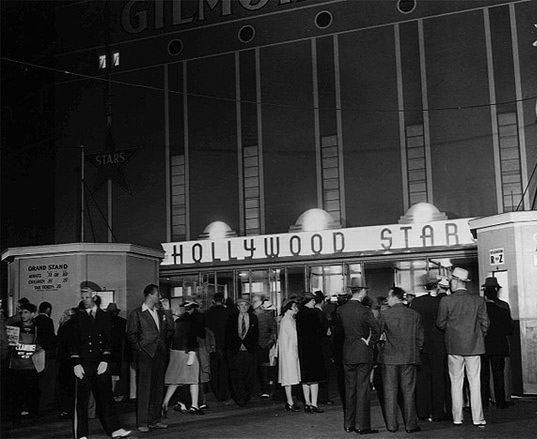 |
|
| (1940s)#** - Fans line up at front entrance to see the Hollywood Stars play a night game. |
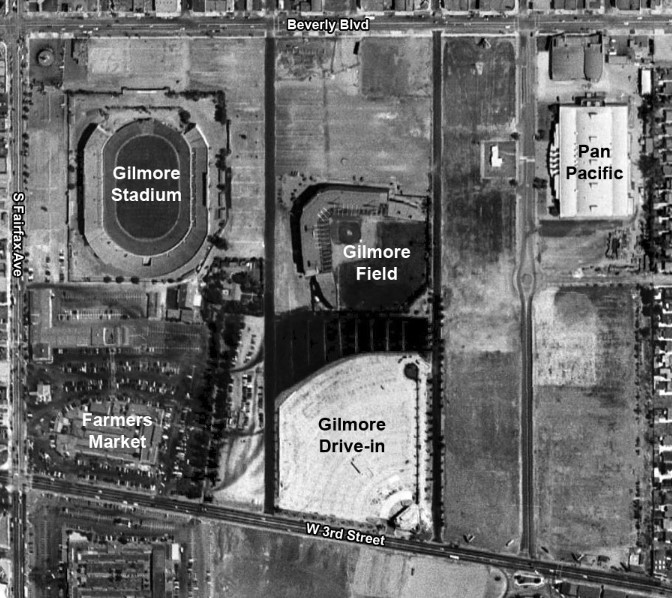 |
|
| (1948)^^* – Aerial view of the area bounded by Beverly, Fairfax, 3rd Street, and Gardner Avenue. Gilmore Field stands smack in the center of the photo surrounded by Gilmore Stadium, Pan Pacific Auditorium, Gilmore Drive-in, and Farmers Market. |
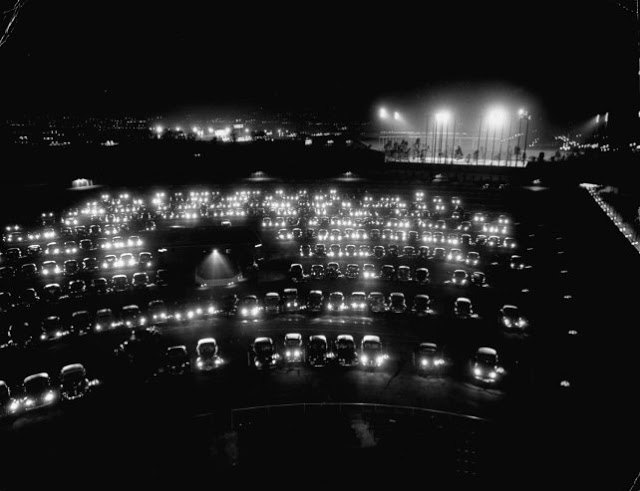 |
|
| (1949)*^^^ - Night view looking north showing three concurrent venues: Movies at the Gilmore Drive-In Theatre (foreground), Hollywood Stars home game at Gilmore Field (upper-right), and a football game at Gilmore Stadium (upper-left). |
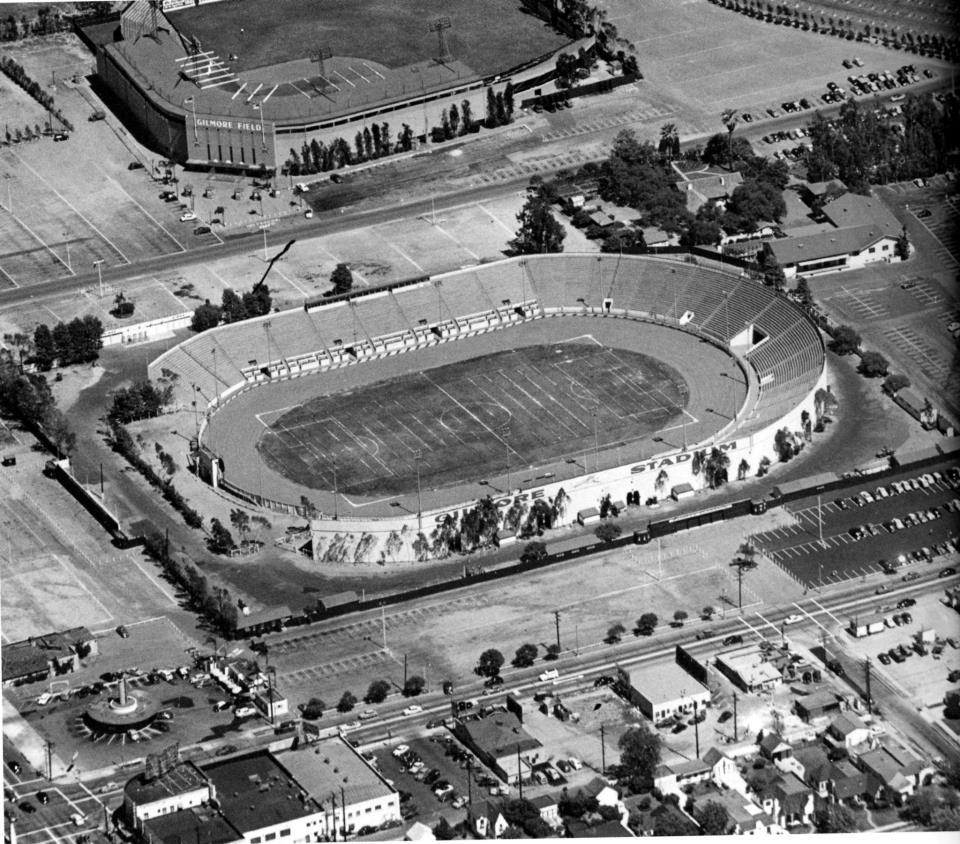 |
|
| (1949)**^ - Aerial view looking southeast of Gilmore Field and Gilmore Stadium. The intersection of Fairfax Avenue and Beverly Boulevard is in the lower left of the photo. Herberts Drive-In Restaurant can be seen on the southeast corner (lower-left). |
Historical Notes In 1952 CBS Television City was built facing Beverly Boulevard on the site of Gilmore Stadium.**^ |
 |
|
| (ca. 1950)#** - Aerial view of Gilmore Field showing a near-full parking lot. A portion of the Gilmore Stadium can be seen in the lower right. |
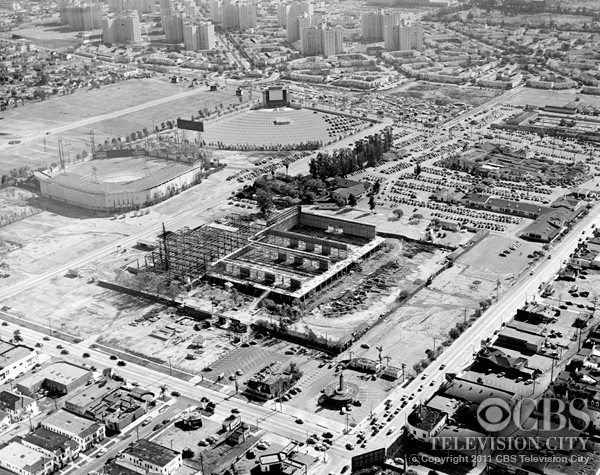 |
|
| (1951)^^* – Aerial view looking southeast showing Gilmore Field surrounded by CBS Television City (under construction at the site of the old Gilmore Stadium), Gilmore Drive-In, Park La Brea Towers, and Farmers Market. Credit: CBS Photo Archive. |
Historical Notes In 1950, the Gilmore Company sold both the football stadium and baseball park to the Columbia Broadcasting System who then announced plans to raze the facility to build a new headquarters - CBS Television City, as it became known. In 1958 Gilmore Field was also demolished and the studio expanded on the grounds where baseball was once played.**^ |
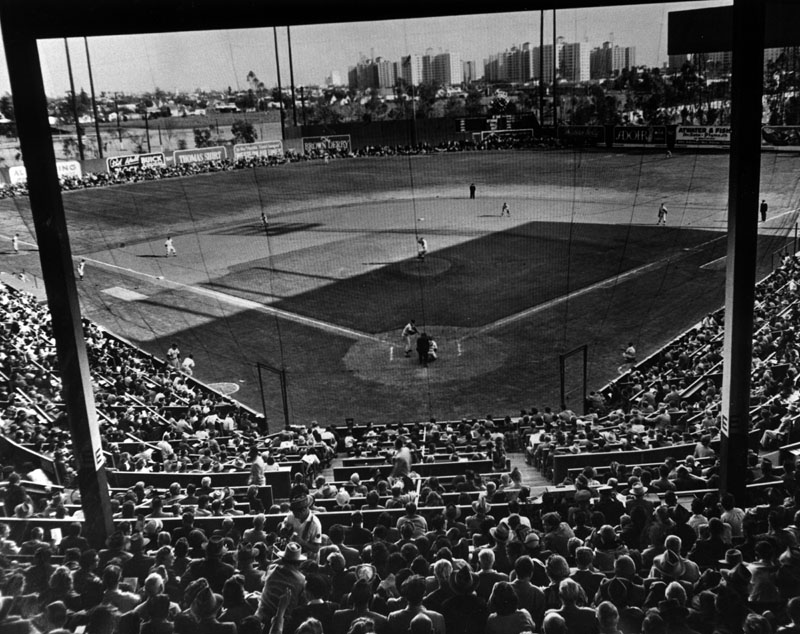 |
|
| (1951)* - Major league All-Stars managed by Ty Cobb and Tris Speaker clashed at Gilmore Field, with the big-leaguers beating the Hollywood Stars, 4-3, for charity. Fans thrilled to Gus Zernial's two homers. This view is looking southeast toward Park La Brea which can be seen in the distance. |
Historical Notes In October 1957, the Brooklyn Dodgers confirmed their long-rumored move to Los Angeles for the 1958 season, which forced the Stars and the Angels to relocate. The Angels, who had been purchased by Dodgers owner Walter O'Malley prior to the 1957 season, became the Spokane Indians in 1958. |
* * * * * |
Baseball in the Coliseum
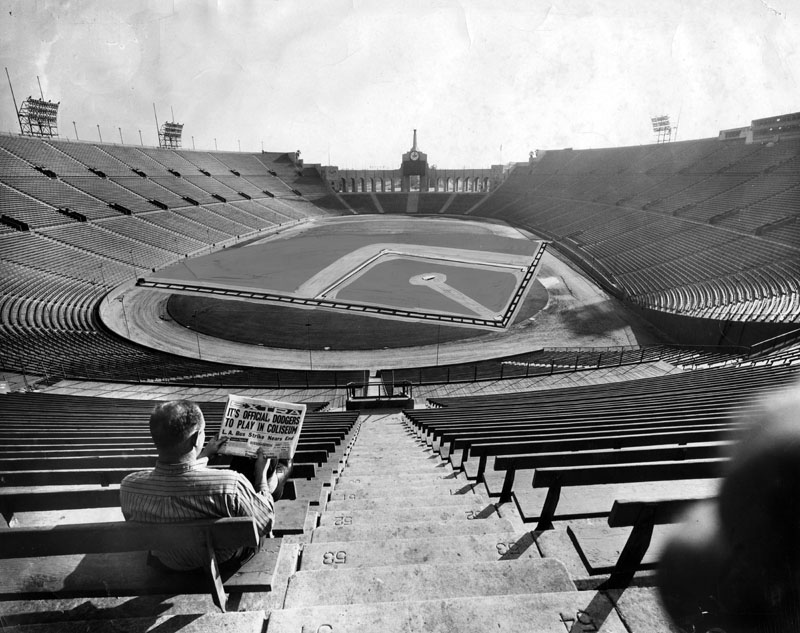 |
|
| (1958)* - View of the Los Angeles Memorial Coliseum where a man is sitting in the 53rd row. The headline of the newspaper that he is holding says, "It's official, Dodgers to play in Coliseum." Photograph caption reads: "Here's Dodger fan's perspective of Coliseum diamond from 53rd row. Dotted lines indicate foul lines on field where Dodgers open season here against Giants April 18." |
Historical Notes While Dodger Stadium was under construction, the Dodgers played in the league's largest capacity venue from 1958 through 1961 at their temporary home, the Los Angeles Memorial Coliseum, which could seat in excess of 90,000 people.*^ |
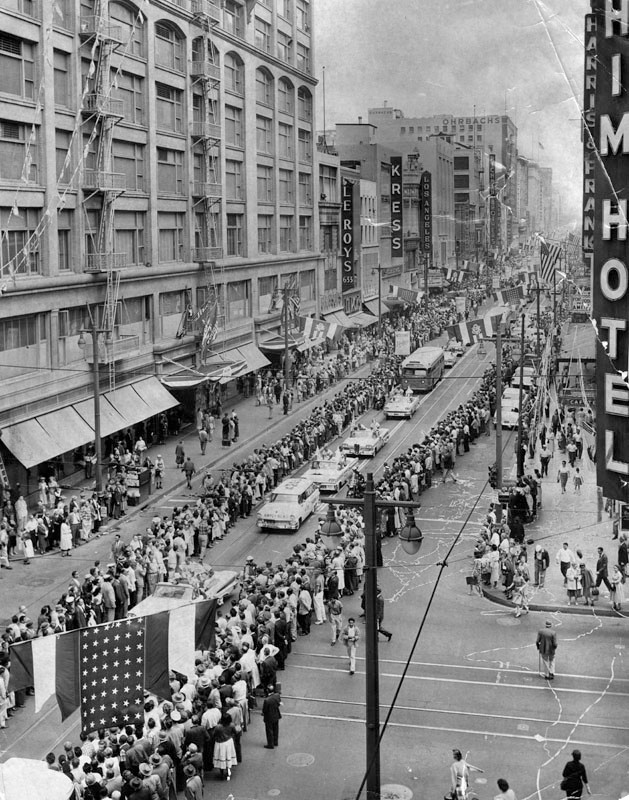 |
|
| (1958)* - The team rides in a motorcade parade down Broadway, en route to the Coliseum for its first game in Los Angeles. |
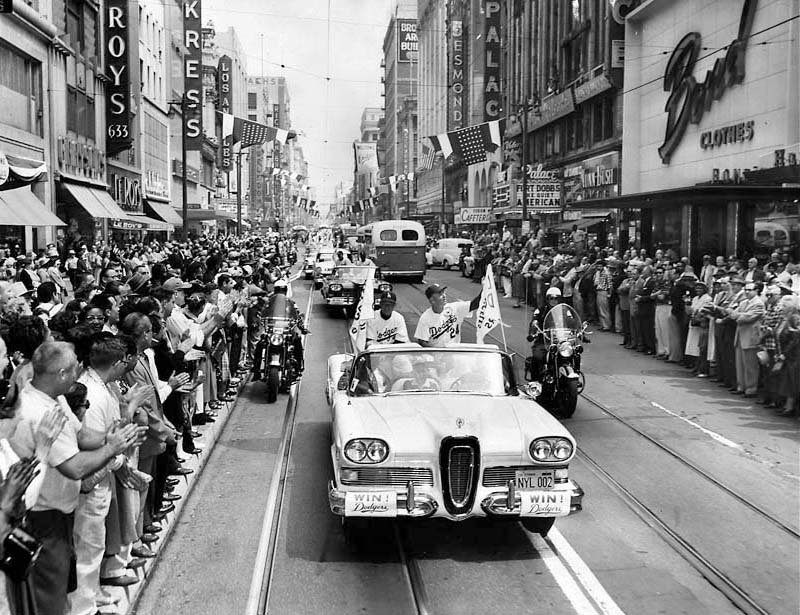 |
|
| (1958)*^^ - Spectators line Broadway as Dodgers Manager Walter Alston, right, and coach Charlie Dressen ride in a caravan to their first game at the Coliseum, April 18, 1958. |
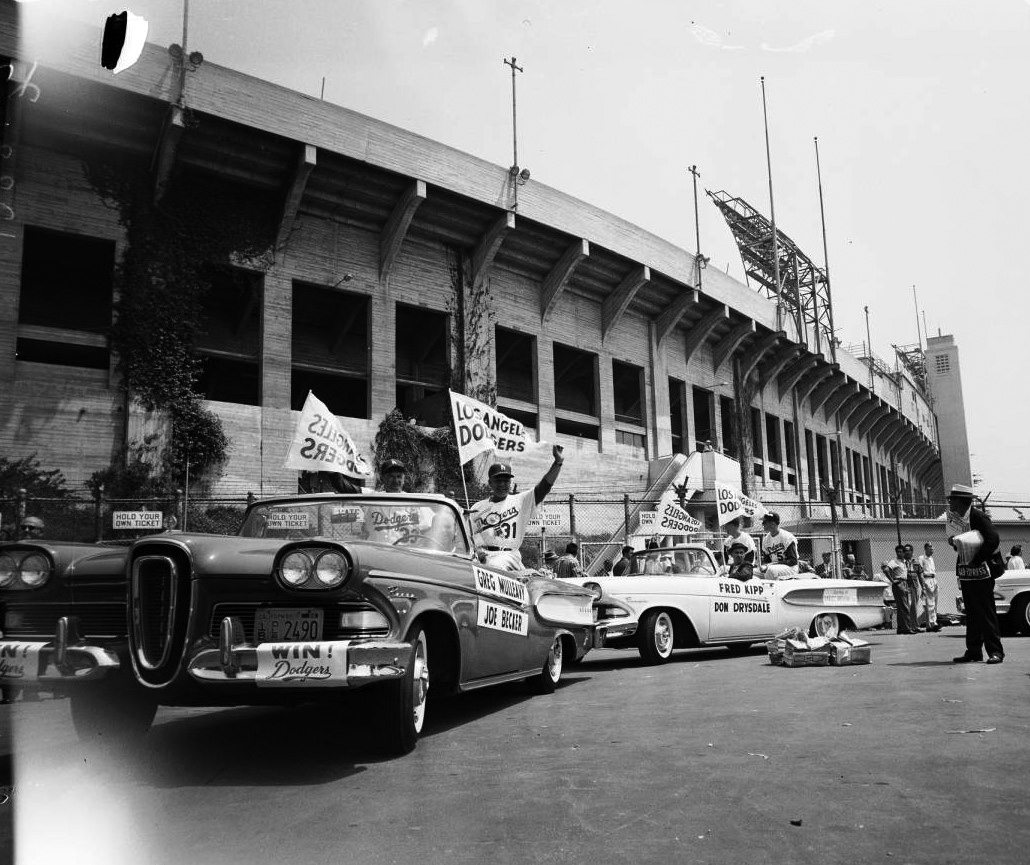 |
|
| (1958)^ – Dodgers arrive at the Coliseum in style before their first game as the 'Los Angeles Dodgers'. |
 |
|
| (1958)^^* - Opening day at the Coliseum, April 18, 1958. The Dodgers played the San Francisco Giants. |
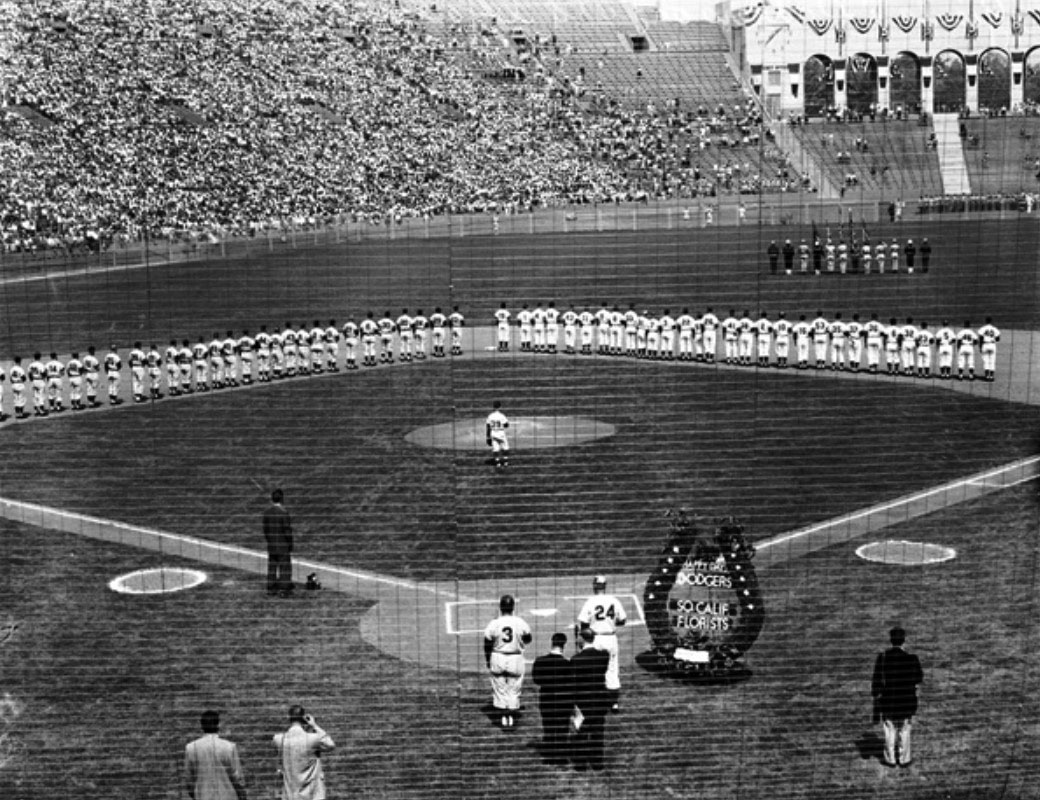 |
|
| (1958)^ - The Los Angeles Dodgers host the San Francisco Giants on Opening Day. Players and spectators stand at attention during the playing of the national anthem. |
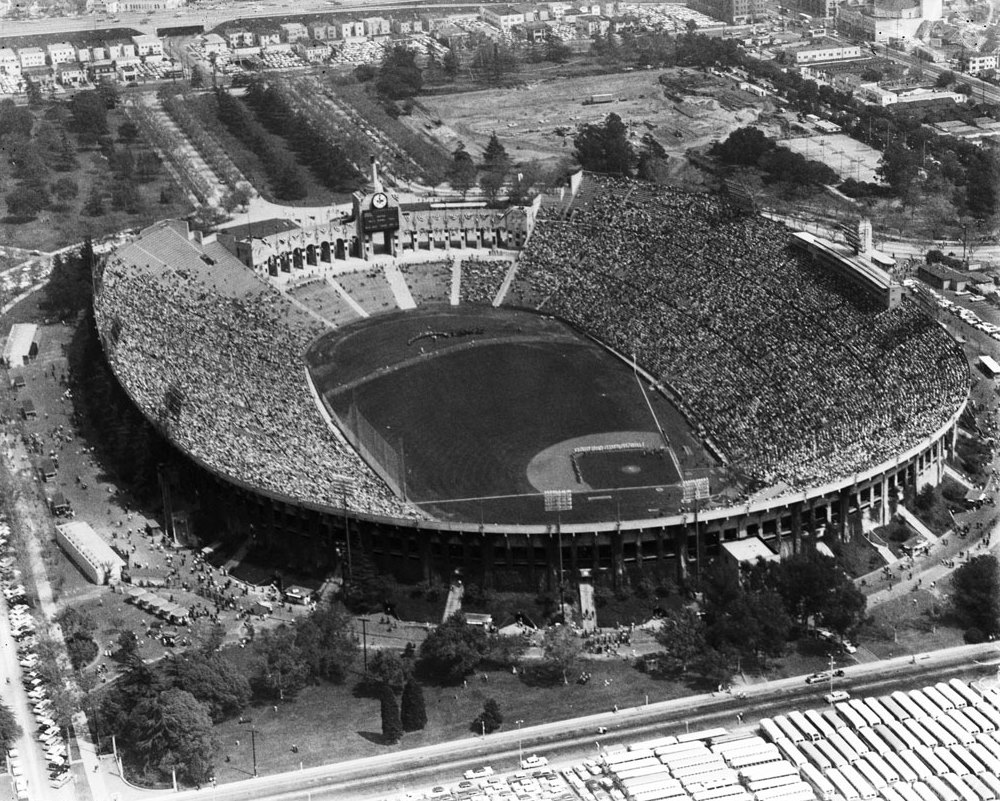 |
|
| (1958)^ - Aerial view of the Coliseum on Dodger’s opening day, April, 18, 1958. |
Historical Notes In their first game in Los Angeles, the Dodgers beat the San Francisco Giants 6-5 in front of 78,672 fans at the Coliseum. Despite their inept play and seventh-place finish, the Dodgers drew a record 1,845,556 fans in their first year in Los Angeles.* |
 |
|
| (1958)* - Closer view of the Dodger's first home game in Los Angeles, before a crowd of 78,672 at the Coliseum. |
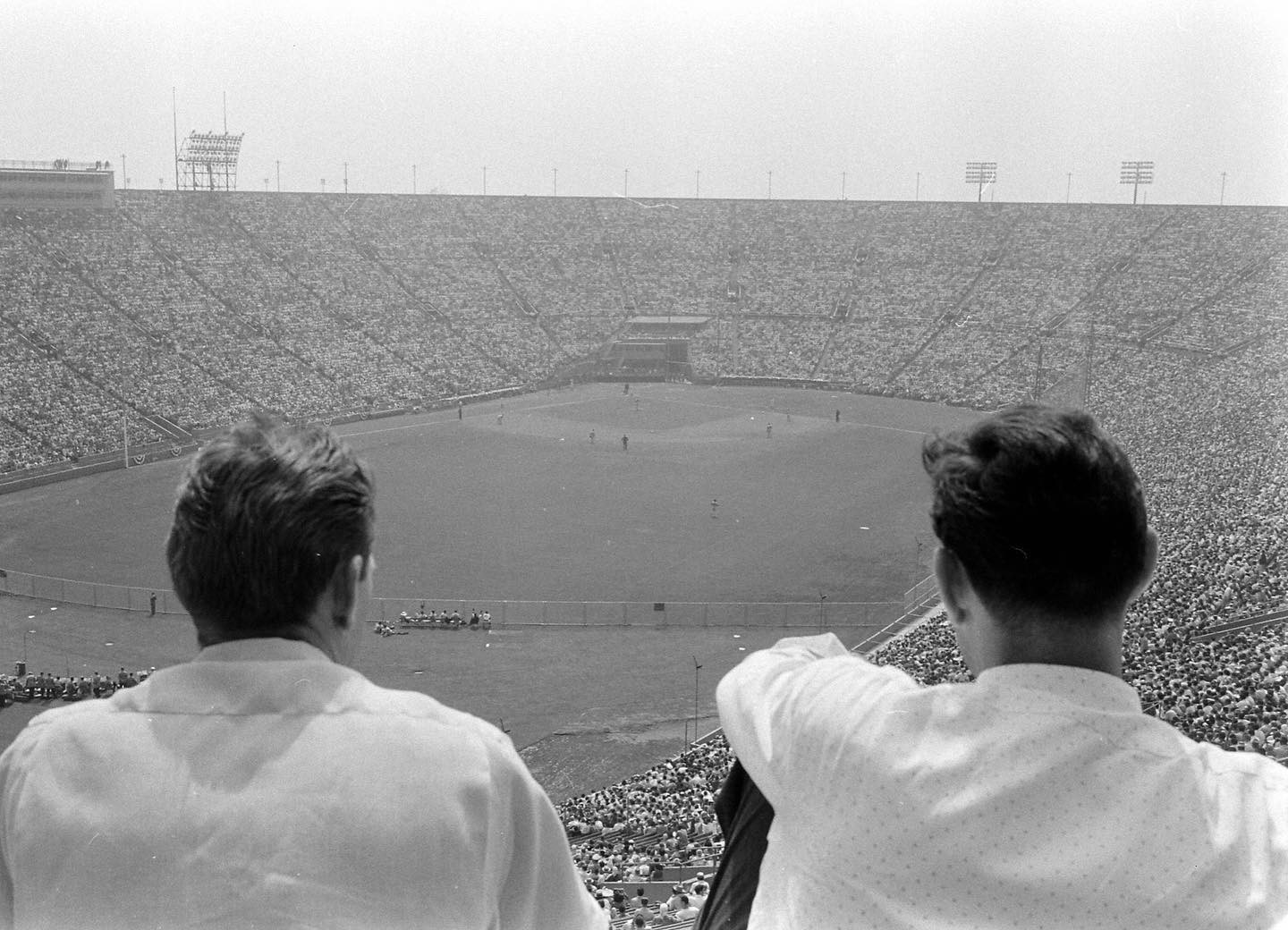 |
|
| (ca. 1958)* - Nice afternoon Dodger game at the Coliseum but unfortunately forgot to bring the binoculars and my eye drops. Photo by Allan Grant for LIFE Magazine. |
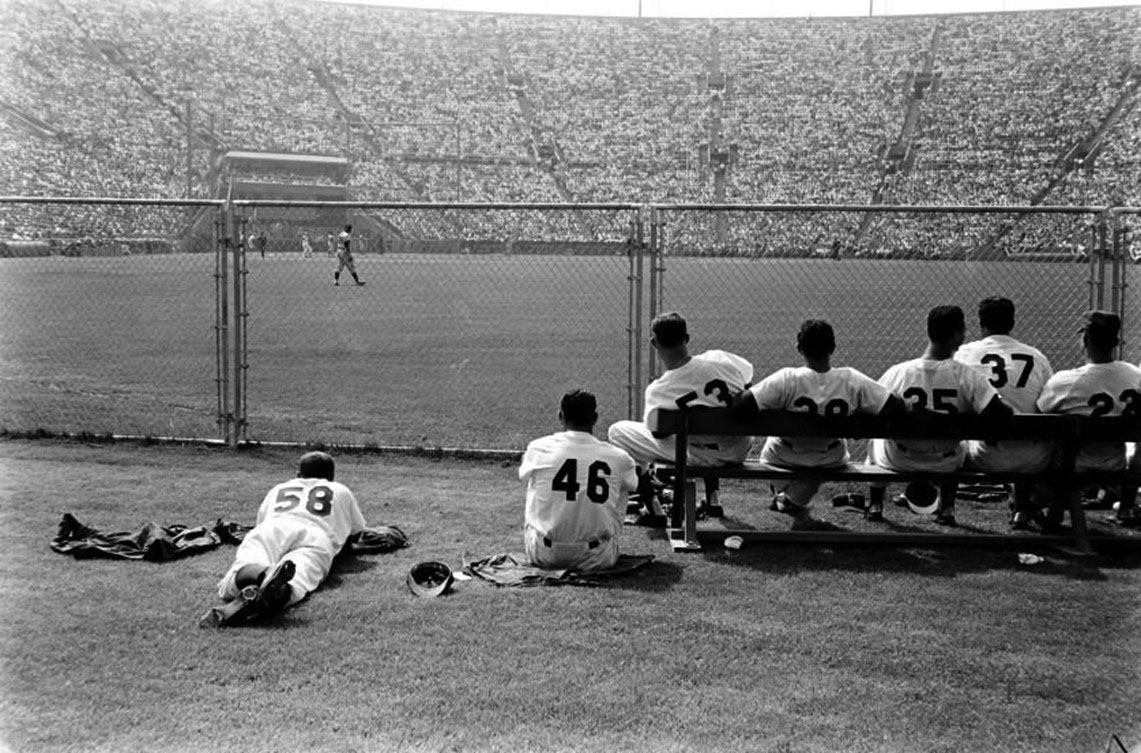 |
|
| (1958)^ - The Dodgers bullpen taking in the first MLB game in Los Angeles (April 18th, 1958) at the Los Angeles Memorial Coliseum. L-R: Joe Pignatano, Don Bessent, Don Drysdale, Ron Negray, Larry Sherry, Ed Roebuck, and Johnny Podres. |
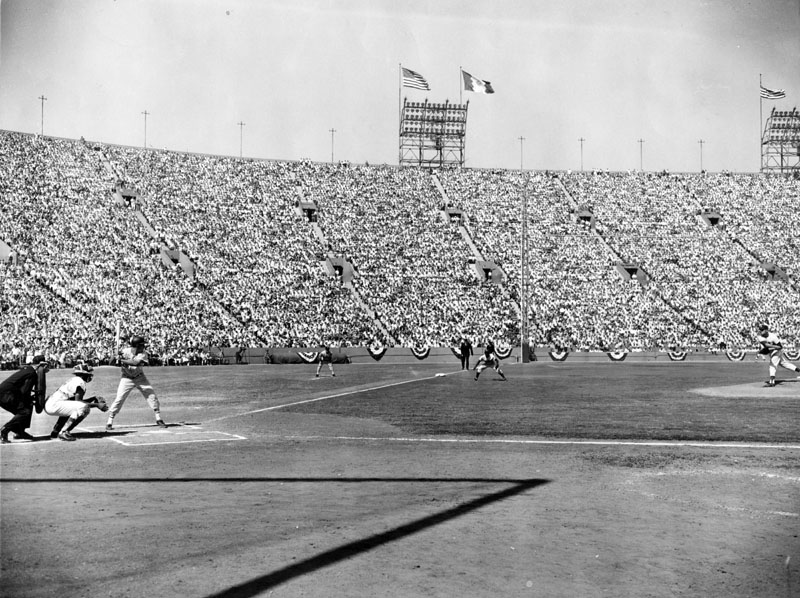 |
|
| (1959)* - Crowds packed the Coliseum to watch the new team in town, the Los Angeles Dodgers, play from 1958 to 1961 setting new records for attendance. |
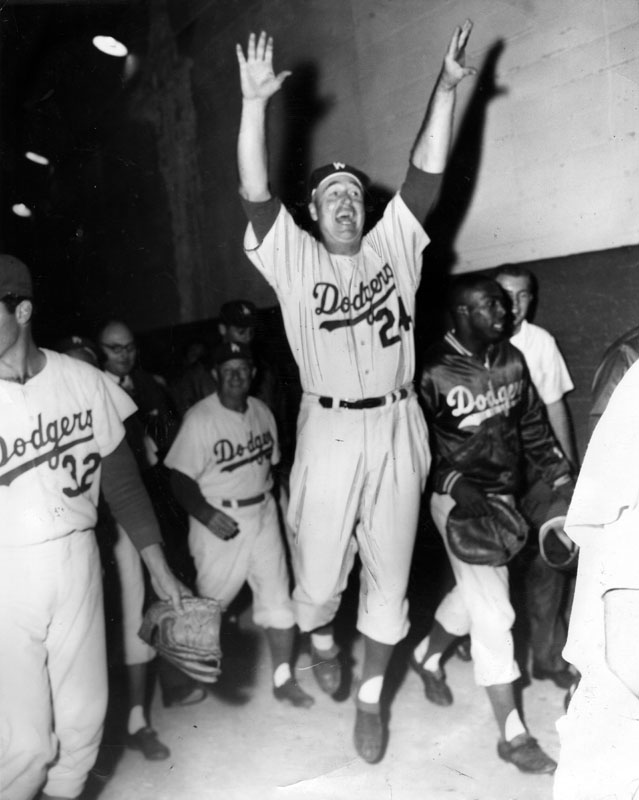 |
|
| (1959)* - Manager Walt Alston being mobbed by players and well-wishers in the tunnel en route to the clubhouse, is so happy that he suddenly stops, leaps in the air and kicks his feet together. His team just won the pennant. |
Historical Notes The 1959 Los Angeles Dodgers finished in a first-place tie with the Milwaukee Braves, with each club going 86-68. The Dodgers won the pennant as they swept the Braves in a best-of-three playoff series. They went on to defeat the Chicago White Sox in the 1959 World Series in just their second season since leaving Brooklyn.*^ Walter Alston won seven National League pennants in his 23 years tenure as Dodgers manager. In 1955 he led Brooklyn to the pennant and its only World Series championship; the team repeated as National League champions in 1956. After the Dodgers moved to Los Angeles, Alston led the team to pennants in 1959, 1963, 1965, 1966 and 1974, and three more world championships (1959, 1963, 1965). He was the first Dodger manager to win a World Series. Named Manager of the Year six times, Alston also guided a victorious NL All-Star squad a record seven times. He retired after the 1976 season with 2,063 wins (2,040 in the regular season and 23 in the postseason).*^ |
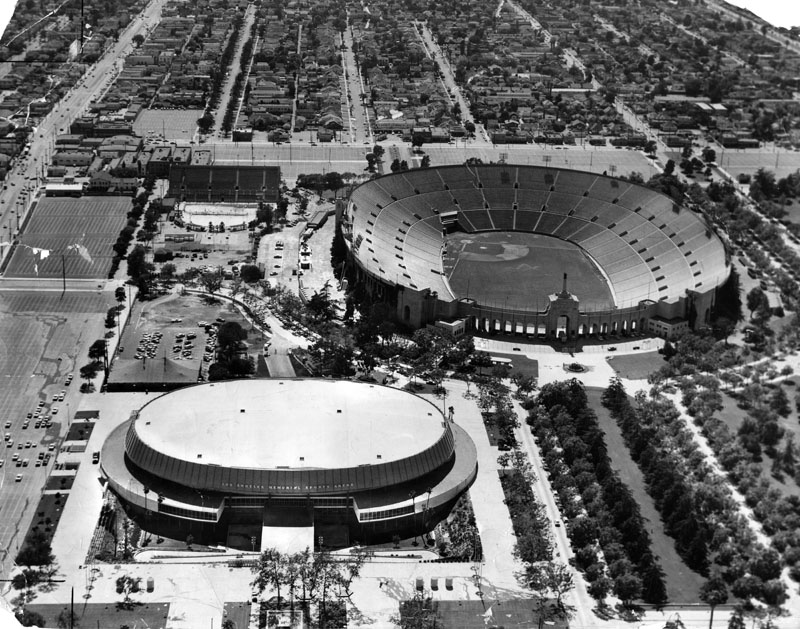 |
|
| (1960)* - Aerial view of both the Los Angeles Memorial Coliseum and adjacent Los Angeles Memorial Sports Arena. The Coliseum was home to the Dodgers between 1958 and 1961. In 1962 the Dodgers would play their first season in a new stadium built just for them - Dodger Stadium. |
* * * * * |
Please Support Our CauseWater and Power Associates, Inc. is a non-profit, public service organization dedicated to preserving historical records and photos. Your generosity allows us to continue to disseminate knowledge of the rich and diverse multicultural history of the greater Los Angeles area; to serve as a resource of historical information; and to assist in the preservation of the city's historic records.
|
More Historical Early Views
Newest Additions
Early LA Buildings and City Views
History of Water and Electricity in Los Angeles
* * * * * |
References and Credits
* LA Public Library Image Archive
^* Library of Congress: Washington Park
^^ Rule 19 Blog - Vernon Tigers
++CulturaPolitics: White Sox Park
## NY Times: Chicago Cubs in Catalina
**^Vintage Los Angeles: Facebook.com
*^^LA Times Framework: Wrigely Field, 1937; Frenchy Uhalt; Dodgers Caravan,1958
#**Classic Hollywood/LA/SFV - Facebook.com
^^^KCET: History of Baseball Stadiums
^^*Skyscraperpage.com: Coliseum Opening Day; Wrigley Field Opening Day; Chutes Park; Gilmore Aerial; CBS Television City
****Pamona Public Library’s Frasher Foto Postcard Collection
*^*^South Bay Daily Breeze: Spring Training with the Cubs on Catalina
^*^*Flickr.com: Michael Ryerson
*^^^Vintage Everyday
^**^Catalina Island Scrapbook: voncoelln.com
*^ Wikipedia: Dodger Stadium; Angels Stadium; Nolan Ryan; Reggie Jackson; Los Angeles Angels (PCL); Los Angeles Angels of Anaheim; Gilmore Field; Chutes Park; Gene Mauch; Hollywood Stars; Bill Russell; Davey Lopes; Tommy Lasorda; L.A. Dodgers - 1959 Season; Walter Alston; William Wrigley, Jr.; Santa Catalina Island
< Back
Menu
- Home
- Mission
- Museum
- Major Efforts
- Recent Newsletters
- Historical Op Ed Pieces
- Board Officers and Directors
- Mulholland/McCarthy Service Awards
- Positions on Owens Valley and the City of Los Angeles Issues
- Legislative Positions on
Water Issues
- Legislative Positions on
Energy Issues
- Membership
- Contact Us
- Search Index